Appx Medicaid Payment Reconciliation Guide
This document offers an explanation and instructions on how to use the Medicaid Payment Reconciliation application. We offer this document as a Wiki page to allow the Medicaid Billing community to add comments and to expand explanations where you feel it is appropriate. Please feel free to login and edit the pages if you find areas that you feel need more clarification.Table of Contents
- Appx Medicaid Payment Reconciliation Guide
- Table of Contents
- Overview
- Starting Appx and the Reconciliation System
- Medicaid Payment Reconciliation Menu System
- Menu-Administration Tab
- Edit Residency Verification Records
- Hospital Per Diem
- Menu-Reconciliation Tab
- Reconciliation Overview
- Download the monthly bill
- Start a Reconciliation Cycle
- Move Billing File to Server
- Import Monthly Billing File
- Reconcile Exception List
- How to Change the Payment Code
- Edit Payment Records/Change Payment Code
- Post Reconciled Bill
- Move Billing File to Desktop
- Reconciliation Recap Report
- Re-print Summary Letter
- Print Exception List – Short Format
- Print Exception List – Long Format
- Print Residency Transfer Forms
- How to upload the reconciled bill
- Menu-Reporting Tab
- Re-Print Reconciliation Recap Report
- Reprint Summary Letter
- Nursing Home Clients with Hospital Bills
- List Medicaid Clients With No Activity
- Payment Analysis Per Client
- Payment Analysis Per Date Range
- Hospital/HMO Payment Report
- Residency File Listing
- Transaction History List
- Batch Payment History Of All Clients
- List Unpaid Transactions By Client
- History Audit/Payments By Batch
- Export Residency File
- Export Payment History File
- Export Selected Batches
- Menu-Special Functions Tab
- Delete A Posted Medicaid Invoice
- Change A Medicaid Number In The History File
- Deny Payments By Billing Code
- Delete Posting With No History
- Delete a Per Diem Data Period
- Rebuild History From Uploaded File
- Rebuild Upload From History
- Build New Exception List
- Terminology
- Non-payment code
- Exception list
- Exception reason
- Residency record
- Reconciliation Cycle
- Posting
- Re-bill
- AHCA
- Exception Reasons
- Not this county
- No residency record
- Resident record not set for NH
- Address change
- Missing required value(s)
- Per Diem values not found
- Per Diem mismatch
- Resident hospital flag not set
- County share is more than the bill amount
- Unpaid record for client
- No record in history for credit offset
- Adj, check for matching credit/debit bills
- Rebill payment previously approved
- Duplicate service date record in history
- Current bill contains duplicates for this service period
- Service date is prior to medicaid admit date
- Service date is later than date of death
- Service date is later than date moved out
- Tips and Techniques
- Known Bugs
- Feature Request
Overview
The Medicaid Payment Reconciliation System (MPR) from APPX Software, Inc is used to reconcile Medicaid Client payment information available to State of Florida Counties. Each county in Florida is required to repay a portion of the Medicaid costs of eligible recipients that are living in a nursing home or receive hospital care. The State of Florida provides a listing (bill) for the clients the county may be liable for and the county’s share for each of those clients. The State also provides access to this data electronically via a downloadable file. While the State verifies each client’s last known address, it remains the County’s responsibility to verify the eligibility of each client and to make sure the client is a resident of that county. Manually reconciling the information the State sends each month can take hours to weeks depending on the volume of transactions. That’s where the MPR system can help. The billing information your county receives is also available through the Internet as a download file. By using that file the MPR system can help you save time and money. The system helps reduce processing time by eliminating over-payments and increasing your efficiency, accuracy, and productivity. How? Processing time is saved by letting MPR do the work for you. It’s estimated that 90% of the transactions are for clients that reside in nursing homes. Each month you have to verify the address for each of these clients to ensure they are county residents. With the MPR system you add a Residency once, set an eligibility flag, and let the MPR system verify the addresses. The 90% that are okay will go through each month without any intervention. You maintain complete control. If a client moves or otherwise becomes ineligible, simply change their eligibility flag and no payments will go through without your approval. With hundreds of clients to review each month, it is easy to miss errors. You may approve a payment for a client that is not from your county, or you may pay for the same service period more than once. Letting MPR validate each request for payment guarantees that you will not accidentally pay for a client you have not verified. The MPR system will look for duplicate payments. As each month is processed, a history file is updated with all the payments, whether approved or denied. All new requests are matched against this history file to ensure you do not pay twice for the same service period. To find out more about Appx, please go to our web site, <a target="_top" href="http://www.appx.com/">http://www.appx.com</a>, or call us at (800) TRY-APPX, (879-2779).Starting Appx and the Reconciliation System
<a target="_blank" href="http://www.appx.com/assets/asp/dynamic_generator.asp?pageid=413">Appx</a> is a computer programming tool for developing business application software. The MPR system operates in the Appx runtime environment. Instructions on how to use and operate applications in the Appx runtime environment can be found in the Appx Users Guide . This icon is typically named Medicaid Reconciliation, or MPR, or Appx. The Appx Desktop Client software starts and displays a window which will allow you to log in to Appx. You must be a valid user defined in Appx to log in to Appx.
See Chapter 2 of the <a target="_blank" href="http://www.appx.com/common/documents/manuals/appx/sysadmin/appx_system_manual.htm">Appx System Administration Manual</a> for details on adding a new user to Appx.
Add the new user in the application using the Billing Worker Code Maintenance function located on the Menu-Administration Tab.
. This icon is typically named Medicaid Reconciliation, or MPR, or Appx. The Appx Desktop Client software starts and displays a window which will allow you to log in to Appx. You must be a valid user defined in Appx to log in to Appx.
See Chapter 2 of the <a target="_blank" href="http://www.appx.com/common/documents/manuals/appx/sysadmin/appx_system_manual.htm">Appx System Administration Manual</a> for details on adding a new user to Appx.
Add the new user in the application using the Billing Worker Code Maintenance function located on the Menu-Administration Tab.
Figure: Appx Client Login Screen
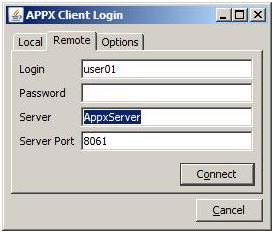 On the Remote tab you must enter your Desktop user id in the Login field, your desktop Password, the name of the Appx server, and the port. The Appx Client software remembers your user id, server name, and port, but you must enter your password every time you wish to log in to Appx. All of these fields are required. Click Connect after entering all the login information and Appx will start.
The Local tab is used to connect to a copy of Appx that may be installed on a local computer. The Options tab has settings for controlling the visual effects of the Appx Client display. Please call support at 1-800-879-2779 for more information regarding the Options and Local tabs. Under most circumstances you will always start from the Remote tab.
When Appx starts the Appx main menu is presented.
On the Remote tab you must enter your Desktop user id in the Login field, your desktop Password, the name of the Appx server, and the port. The Appx Client software remembers your user id, server name, and port, but you must enter your password every time you wish to log in to Appx. All of these fields are required. Click Connect after entering all the login information and Appx will start.
The Local tab is used to connect to a copy of Appx that may be installed on a local computer. The Options tab has settings for controlling the visual effects of the Appx Client display. Please call support at 1-800-879-2779 for more information regarding the Options and Local tabs. Under most circumstances you will always start from the Remote tab.
When Appx starts the Appx main menu is presented.
Figure: Appx Main Menu
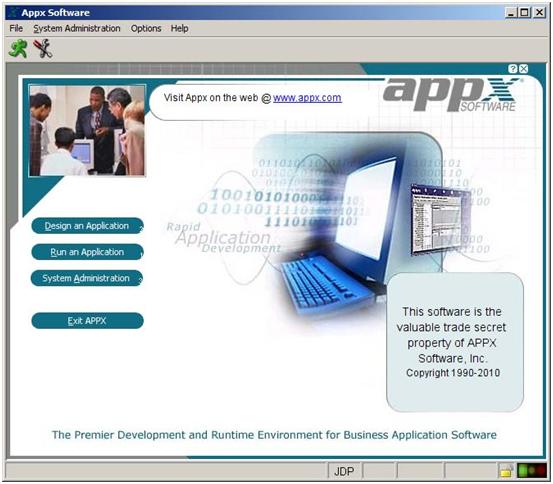 From the Appx main menu you can start the MPR system, alter the Appx environment, or modify the MPR programs. There may be times you want to maintain or modify the system however someone from Appx will be helping you with that. To start the MPR system for reconciliation click on Run an Application and enter the three character “Database ID” for your county. Each county has a different Database ID. You can click on the binoculars and search the list to find the Database for the MPR system.
From the Appx main menu you can start the MPR system, alter the Appx environment, or modify the MPR programs. There may be times you want to maintain or modify the system however someone from Appx will be helping you with that. To start the MPR system for reconciliation click on Run an Application and enter the three character “Database ID” for your county. Each county has a different Database ID. You can click on the binoculars and search the list to find the Database for the MPR system.
Figure: Select Database ID Screen
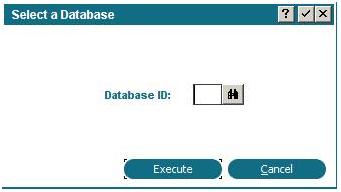 After entering or selecting the Database ID press enter or click Execute and the MPR system will start and the MPR Medicaid Payment Reconciliation Administration Menu will appear.
After entering or selecting the Database ID press enter or click Execute and the MPR system will start and the MPR Medicaid Payment Reconciliation Administration Menu will appear.
Medicaid Payment Reconciliation Menu System
The MPR menu is organized into five tabs, Current Status, Administration, Reconciliation, Reporting, and Special Functions. Clicking on a Tab will take you that particular menu. Clicking on the work Exit will close the application and end your Appx session. Menus, Current Status TabFigure: Current Status Tab
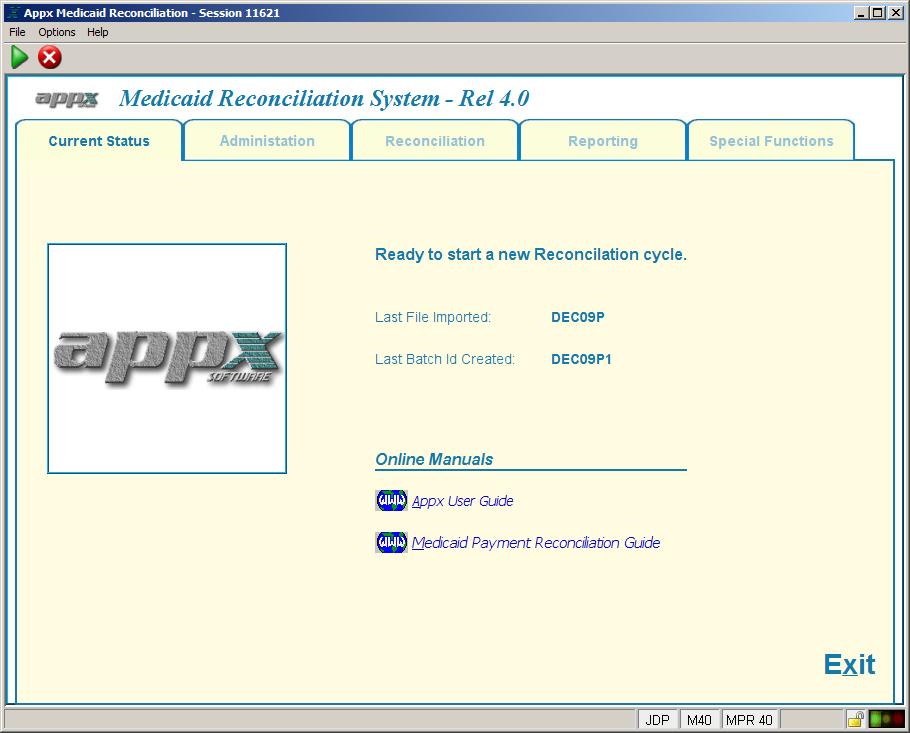 The illustration above shows the Current Status Menu. This is the starting point for the MPR system. The large Appx icon shown can be replaced with your counties logo. The status menu shows your current status in the reconciliation cycle, the last billing file you imported and the batch name created for that file.
You can conveniently get to the online manuals. The Appx Users Guide
The illustration above shows the Current Status Menu. This is the starting point for the MPR system. The large Appx icon shown can be replaced with your counties logo. The status menu shows your current status in the reconciliation cycle, the last billing file you imported and the batch name created for that file.
You can conveniently get to the online manuals. The Appx Users GuideHow to Add a County Logo
The logo is a picture file and must be named CountyLogo.PNG (PNG is the required file format. Appx also support jpg and gif file formats. Please call for help in using one of these formats if you cannot convert to PNG. Replace the file in the Appx\data\40\Mpr\Resource named similarly and you will see your image on this menu as well as other places the Logo file is used the next time you log in to Appx.Menu-Administration Tab
Figure: Administration Tab
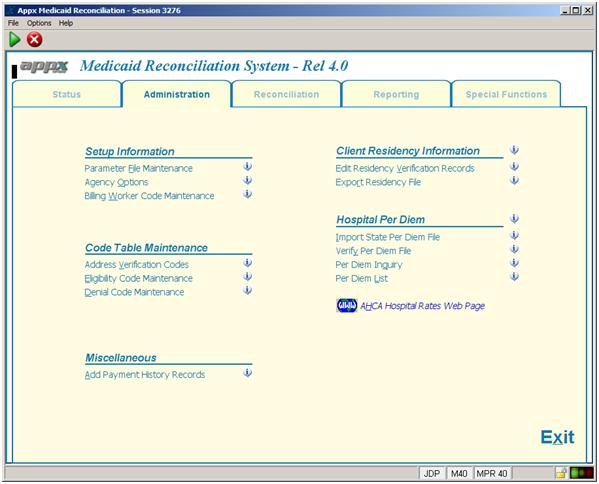 The illustration above shows the Administration Menu. The functions on this menu are used to access files and records that control how the monthly billing file is processed. Items on this menu are grouped into five categories. Setup Information is used for general reconciliation cycle control. Code Table Maintenance is used for specific codes referenced within the system. Client Residency Information is for entering and maintaining Residency record information on clients. Hospital Per Diem is used to maintain Per Diem rates.
The exclamation point in the bubble (info bubble,
The illustration above shows the Administration Menu. The functions on this menu are used to access files and records that control how the monthly billing file is processed. Items on this menu are grouped into five categories. Setup Information is used for general reconciliation cycle control. Code Table Maintenance is used for specific codes referenced within the system. Client Residency Information is for entering and maintaining Residency record information on clients. Hospital Per Diem is used to maintain Per Diem rates.
The exclamation point in the bubble (info bubble, Parameter File Maintenance
Figure: Parameter File Maintenance Screen
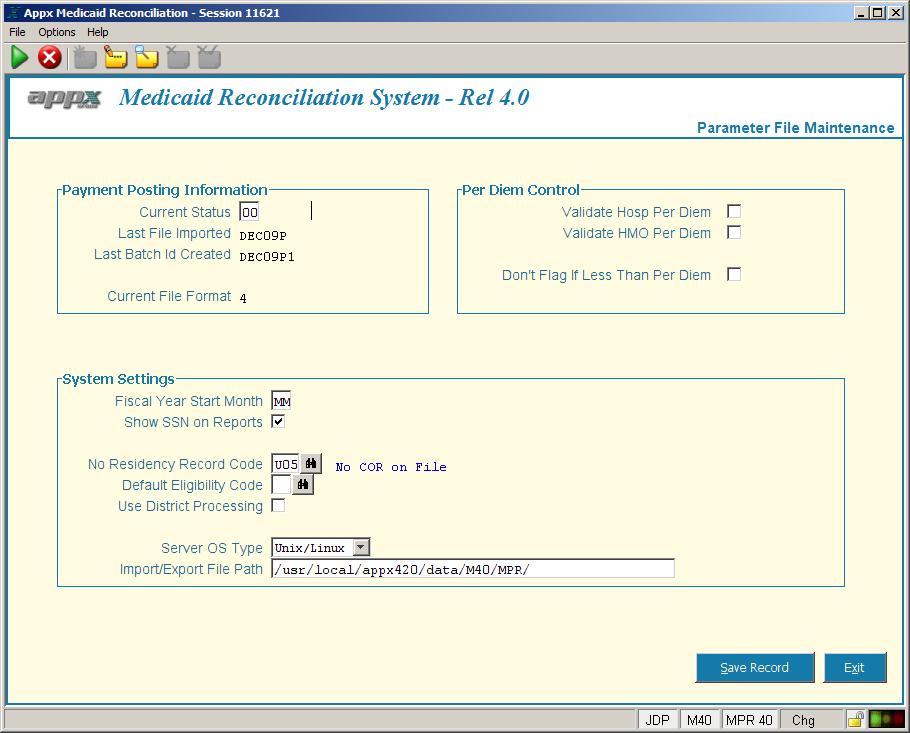 This input process is used to maintain your MPR system settings.
Caution should be taken before changing any settings on this screen.
The Payment Posting Information section contains information about the reconciliation cycle (batch). Reconciliation is a multi-step process. These steps need to be completed in order. The Current Status field is an internal pointer indicating which step you are currently in. The MPR system will automatically change the status code as you proceed through reconciling your monthly bill. Please do not change this number unless someone from Appx asks you to do so.
The Last File Imported is the name of the bill that you are either working on just finished. Last Batch ID Created is the internal name the MPR system gave the batch you imported. A digit is added to provide uniqueness if another batch for the month is imported.
Per Diem Control. This section enables or disables the per diem editing feature of the MPR system. Read more about per diem and the function of these settings below.
System Settings. Fiscal Year Start Month can be set to your fiscal period starting month. There are a few reports that can be sorted by fiscal year. Show SSN on Reports instructs the system to not show social security numbers on printed reports. The SSN will still be displayed on input screens for you to use for client verification. Default Eligibility Code is the default eligibility code you wish to have placed on Residency records that you create from the monthly bill or that are imported into the system. Use District Processing, if your county uses district level processing set this field to yes, otherwise it should be set to no (unchecked). The Server OS Type is for identifying the operating system (OS) type. The MPR system needs this to determine the OS command structure syntax. Import/Export File Path is the complete OS path to your MPR system data directory. If the Appx system is moved to another location on the current server or move to a different location on another server this path must be changed.
Please call Appx before changing any of these fields. The MPR system will not function if the settings on the Parameter File screen do not match your computing environment.
This input process is used to maintain your MPR system settings.
Caution should be taken before changing any settings on this screen.
The Payment Posting Information section contains information about the reconciliation cycle (batch). Reconciliation is a multi-step process. These steps need to be completed in order. The Current Status field is an internal pointer indicating which step you are currently in. The MPR system will automatically change the status code as you proceed through reconciling your monthly bill. Please do not change this number unless someone from Appx asks you to do so.
The Last File Imported is the name of the bill that you are either working on just finished. Last Batch ID Created is the internal name the MPR system gave the batch you imported. A digit is added to provide uniqueness if another batch for the month is imported.
Per Diem Control. This section enables or disables the per diem editing feature of the MPR system. Read more about per diem and the function of these settings below.
System Settings. Fiscal Year Start Month can be set to your fiscal period starting month. There are a few reports that can be sorted by fiscal year. Show SSN on Reports instructs the system to not show social security numbers on printed reports. The SSN will still be displayed on input screens for you to use for client verification. Default Eligibility Code is the default eligibility code you wish to have placed on Residency records that you create from the monthly bill or that are imported into the system. Use District Processing, if your county uses district level processing set this field to yes, otherwise it should be set to no (unchecked). The Server OS Type is for identifying the operating system (OS) type. The MPR system needs this to determine the OS command structure syntax. Import/Export File Path is the complete OS path to your MPR system data directory. If the Appx system is moved to another location on the current server or move to a different location on another server this path must be changed.
Please call Appx before changing any of these fields. The MPR system will not function if the settings on the Parameter File screen do not match your computing environment.
Agency Options
Figure: Agency Options Screen
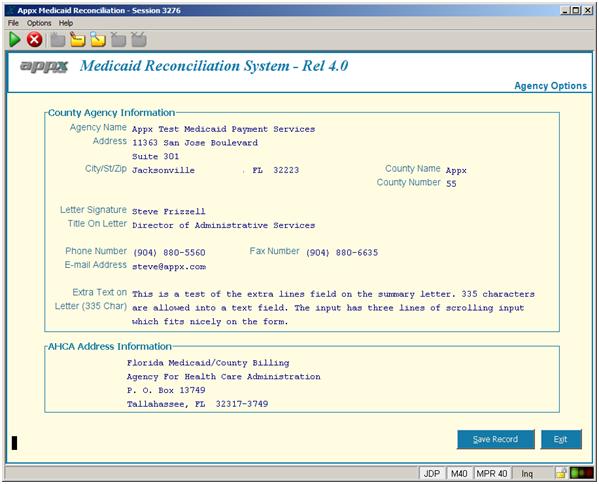 This is where you enter your county’s specific information. Much of this information is printed on the Reconciliation Summary Report. You also identify your county number to the MPR system. This is very important because the county number entered on the Agency Options screen is compared to every record in the billing file. If the numbers aren't the same the record will be listed as an exception.
There is a place where you can enter optional text that will print on the summary letter. This text is printed whether the summary is coming from the current cycle or from history.
This is where you enter your county’s specific information. Much of this information is printed on the Reconciliation Summary Report. You also identify your county number to the MPR system. This is very important because the county number entered on the Agency Options screen is compared to every record in the billing file. If the numbers aren't the same the record will be listed as an exception.
There is a place where you can enter optional text that will print on the summary letter. This text is printed whether the summary is coming from the current cycle or from history.
Billing Worker Code Maintenance
Figure: Billing Worker ID Screen
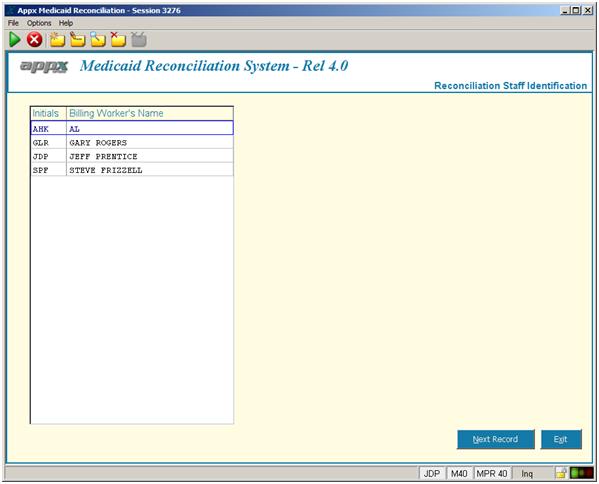 Enter the initials and full name of the people in your county that maintain the MPR system. The user’s ID is automatically added to audit information within the system.
Enter the initials and full name of the people in your county that maintain the MPR system. The user’s ID is automatically added to audit information within the system.
Address Verification Codes
Figure: Residency Address Verification Codes (Examples)
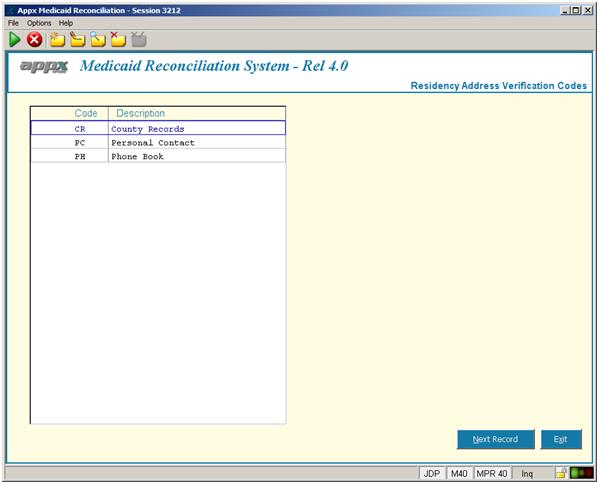 These codes will be used on the Residency record for documenting the method or source of information you used to evaluate and set the eligibility for the client. For example, if you used a phone book to determine if this client is a county resident you might have a code PH or PB.
These codes will be used on the Residency record for documenting the method or source of information you used to evaluate and set the eligibility for the client. For example, if you used a phone book to determine if this client is a county resident you might have a code PH or PB.
Eligibility Code Maintenance
Figure: Eligibility Code Maintenance Screen
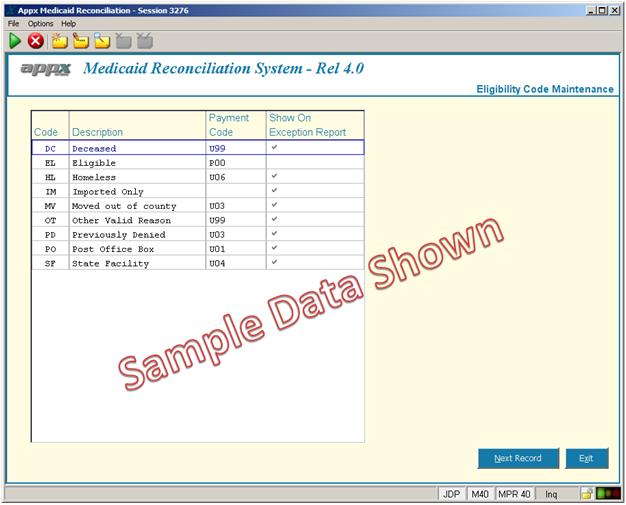 Maintain the code(s) for designating the client’s eligibility. Eligibility is assigned on the Residency record maintenance screen. Defining Residency records and identifying eligibility is the cornerstone of the MPR system. You can have multiple codes for eligibility, check the Auto Except box if this eligibility code designates and exception record that must be reviewed.
With eligibility code you can specify a default Payment Code. When the monthly bill is imported, the MPR system checks for a Residency record for each client. If a match is found and the eligibility is coded on the Residency record, the default Payment Code will be used on the incoming billing record. Notice in the example below that we still want to see these “automatically coded” records on the Exception Report (Show On Exception Report is checked).
Maintain the code(s) for designating the client’s eligibility. Eligibility is assigned on the Residency record maintenance screen. Defining Residency records and identifying eligibility is the cornerstone of the MPR system. You can have multiple codes for eligibility, check the Auto Except box if this eligibility code designates and exception record that must be reviewed.
With eligibility code you can specify a default Payment Code. When the monthly bill is imported, the MPR system checks for a Residency record for each client. If a match is found and the eligibility is coded on the Residency record, the default Payment Code will be used on the incoming billing record. Notice in the example below that we still want to see these “automatically coded” records on the Exception Report (Show On Exception Report is checked).
Figure: Example of Eligibility Code Table (Examples)
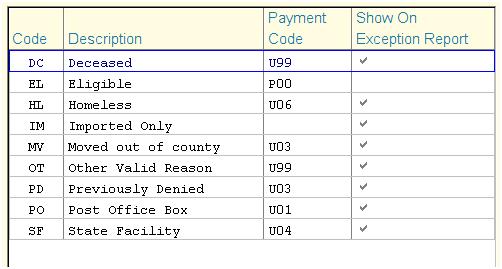
Denial Code Maintenance
Figure: Denial Code Maintenance Screen
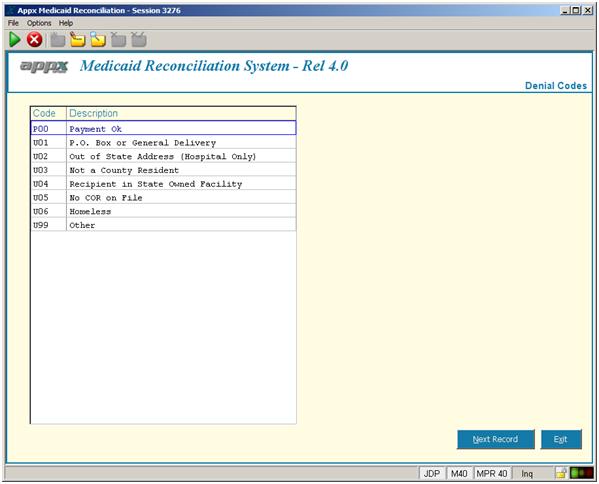 These codes are set by the State. This function is designed to maintain these pre-determined codes. If the State adds or deletes a code you can quickly modify this table using this function.
These codes are set by the State. This function is designed to maintain these pre-determined codes. If the State adds or deletes a code you can quickly modify this table using this function.
Add Payment History Records
This input process allows you to enter data into the history files. Use this function to manually add billing history records. Note that MPR will automatically maintain a history for each batch that is imported and processed.Edit Residency Verification Records
Residency records are the cornerstone of saving you time with the MPR system. As each client record in the monthly bill is processed by the MPR system, it is cross referenced to the Residency file. If a matching Residency record is found, the Eligibility code will determine what will happen to that billing record. If a Residency record is not found then the billing record will be listed on the Exception List. When reconciling a bill you are looking at the Exception List. These are billing records that basically have not been pre-approved. Pre-approval is the function the Residency record. You can add a Residency record directly from the Exception List, then examine the clients address information and assign an Eligibility Code. There are two addresses that you need to be concerned about, the Legal Address and the Hospital Address. A single Residency record will store both address and the MPR system will alert you if the billing record address has changed from the Residency record address. Next month, and each month after that, when the bill is processed the system will find the Residency record you added and use it to automatically code the billing record. You maintain complete control of what is automatically coded and can override what the system does on any billing record.Figure: Residency Address Verification Screen
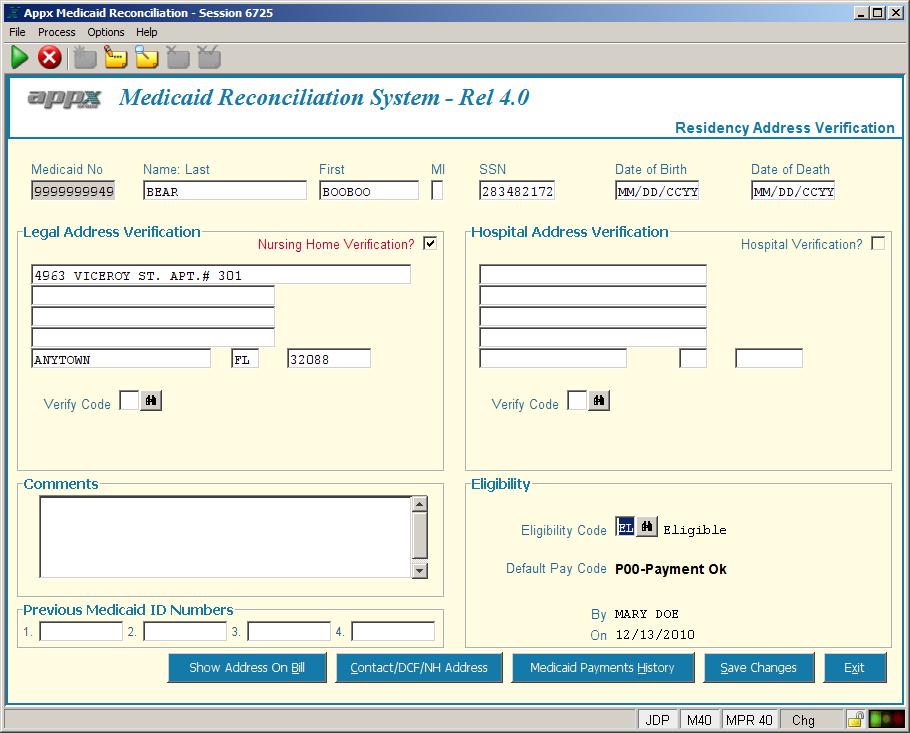 Above is the Residency record screen. Notice the two areas for address information. Click on the button Show Address On Bill to see the address that is on the exception report. Any differences will be highlighted in red unless the field on the exception report is blank. Below is an example of this same Residency record with a correction noted from the bill. Notice the apartment number is missing on the billing record.
Above is the Residency record screen. Notice the two areas for address information. Click on the button Show Address On Bill to see the address that is on the exception report. Any differences will be highlighted in red unless the field on the exception report is blank. Below is an example of this same Residency record with a correction noted from the bill. Notice the apartment number is missing on the billing record.
Figure: Address Verification Screen With Billing Address Overlay
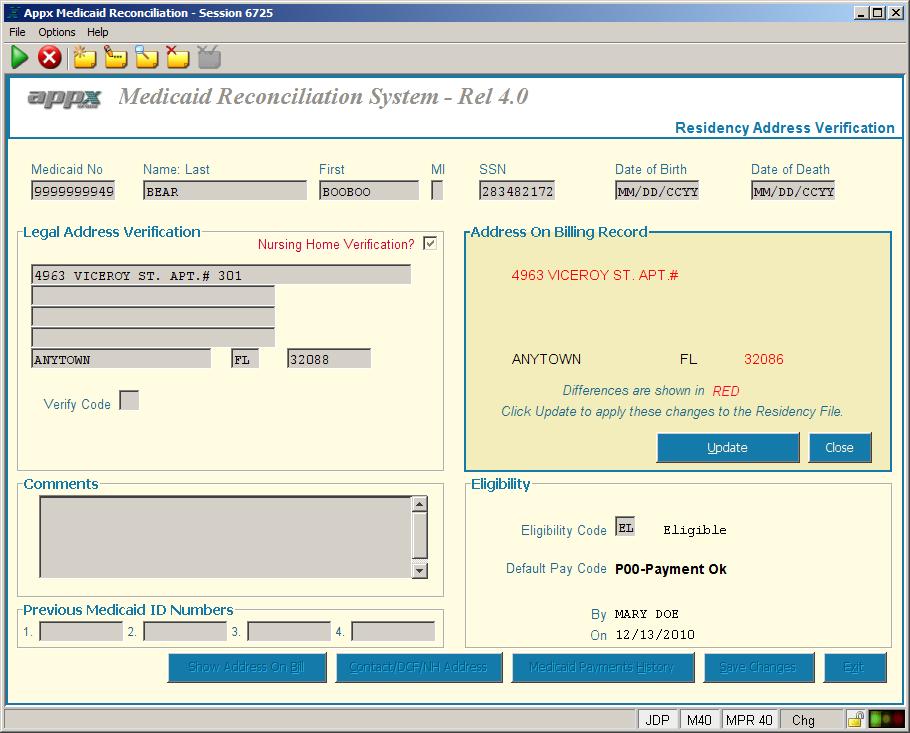 When the Address on Billing Record is displayed you can update your Residency data by clicking the Update button. Clicking Update will replace the address in the Residency file with the address from the billing exception list. Note that the new address or change may effect the client eligiblity. Review this new information and set the Eligibility Code as needed. Click on the Close button to return to the Residency screen.
From the Residency record screen you can invoke other process. Client Contact Information for storing the clients’ legal representative public assistance case worker, and Nursing Home information. Medicaid Payments History shows prior activity for this client.
A Residency record must be identified for nursing home verification and/or Hospital verification. There are two check boxes for identifying the type of Residency record verification intended for this client. Nursing Home Verification Residency records are common, perhaps one for each client on the bill.
When the Address on Billing Record is displayed you can update your Residency data by clicking the Update button. Clicking Update will replace the address in the Residency file with the address from the billing exception list. Note that the new address or change may effect the client eligiblity. Review this new information and set the Eligibility Code as needed. Click on the Close button to return to the Residency screen.
From the Residency record screen you can invoke other process. Client Contact Information for storing the clients’ legal representative public assistance case worker, and Nursing Home information. Medicaid Payments History shows prior activity for this client.
A Residency record must be identified for nursing home verification and/or Hospital verification. There are two check boxes for identifying the type of Residency record verification intended for this client. Nursing Home Verification Residency records are common, perhaps one for each client on the bill.
Hospital Per Diem
The Hospital Per Diem section contains processes that allow you to import and inquire the State per diem rates. *Hospital rates are rates which Medicaid reimburses Medicaid participating hospitals for services provided on a fee for service basis to Medicaid recipients. This includes rates based on Legislative directions provided in the General Appropriations Act for each state fiscal year, which may exempt certain hospitals from rate reimbursement ceilings. Effective July 1, 2005, the cost of exempting certain hospitals from reimbursement ceilings is included in the capitation rates paid to Medicaid managed care organizations. Rates published are effective as of the first day of the rate semester (January 1st/July 1st). This web site is not updated for increases or decreases in rates due to revisions to cost data (such as amended cost reports or audits). For individual updated hospital rates, please contact your local Area Medicaid Offices or AHCA Medicaid Cost Reimbursement at (850) 414-2759. *This information is taken from the AHCA web site.Hospital Per Diem Overview
The Appx Medicaid Reconciliation system can import the Medicaid Reimbursement Rates and optionally check the hospital billing records to ensure the amount charged matches the pre-set per diem rate. If the rate does not match then the record will be listed on the exception report with an appropriate message. You then decide to pay or not pay (reimburse) based on your county‘s criteria. Please take note that Per Diem editing is an optional feature. By default the MPR system will not validate Per Diem. See the detailed instructions Activating Per Diem Editing below to activate this feature. If Per Diem checking is active on your system ensure that all the relevant files have been processed before importing your monthly bill.Downloading the Hospital Per Diem
Click on the WWW icon or the words AHCA Hospital Rates Web PageFigure: AHCA Web Site for Downloading Per Diem
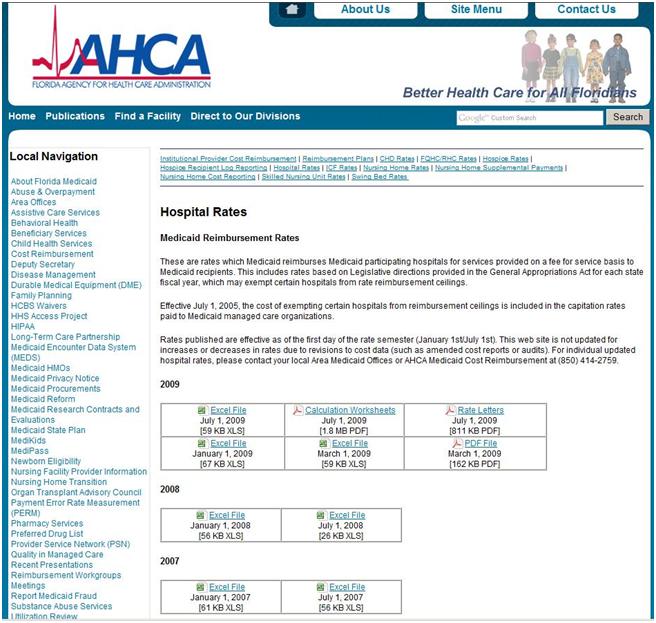 There are two sets of rates. Scroll the screen down until you see Medicaid Rates/County Billing Porposes Only. These are the rates to use for Per Diem editting in the MPR system. The file you download includes all the providers within Florida. There are not specific files for each county as with the bill. The file will download as a spreadsheet (xls, Excel). Open this file with Excel and save it as a tab delimited text file to the /Download directory. Name the file using the standard MMMYYx format. For example, JAN05H . Use H to identify this file as a hospital per diem file.
Important note: There are several years/semesters available for downloading under the heading Medicaid Rates/County Billing Purposes Only. You will need to download files to cover the anticipated service dates for the billing records you are currently receiving from the State.
There are two sets of rates. Scroll the screen down until you see Medicaid Rates/County Billing Porposes Only. These are the rates to use for Per Diem editting in the MPR system. The file you download includes all the providers within Florida. There are not specific files for each county as with the bill. The file will download as a spreadsheet (xls, Excel). Open this file with Excel and save it as a tab delimited text file to the /Download directory. Name the file using the standard MMMYYx format. For example, JAN05H . Use H to identify this file as a hospital per diem file.
Important note: There are several years/semesters available for downloading under the heading Medicaid Rates/County Billing Purposes Only. You will need to download files to cover the anticipated service dates for the billing records you are currently receiving from the State.
Import State Per Diem File
The file you downloaded from the internet and saved in the /Download directory needs to be imported into the Medicaid Reconciliation system. The import process reads each record in the downloaded file and saves the information to a file in the MPR system. Click the Import State Per Diem File. The following screen pops up.Figure: Import State Per Diem Screen
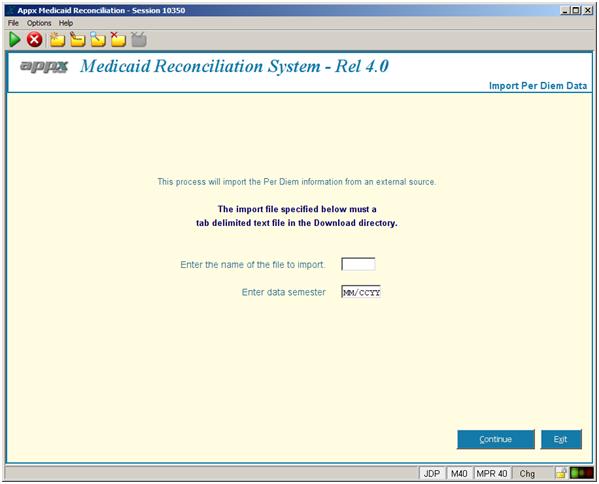 There are two fields that must be entered. The first field is the name of the file you downloaded and saved (MMMYYx format) in the /Download folder. The second field is for defining the semester; enter either 01 or 07 and the four digit year. The semester is the six month period the import file covers. The system does not check to see if the file name and the semester are equivalent. See next section for details.
If the name of the file to import cannot be found in the /Download directory a message similar to the following will be displayed.
There are two fields that must be entered. The first field is the name of the file you downloaded and saved (MMMYYx format) in the /Download folder. The second field is for defining the semester; enter either 01 or 07 and the four digit year. The semester is the six month period the import file covers. The system does not check to see if the file name and the semester are equivalent. See next section for details.
If the name of the file to import cannot be found in the /Download directory a message similar to the following will be displayed.
Figure: Per Diem Import File Error
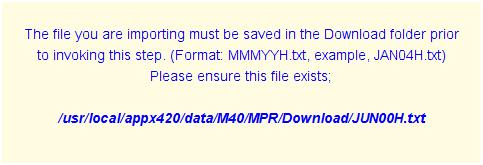 Since the incoming data covers a six month semester beginning in either January (01) or July (07), the date entered for the period is the beginning month for the period. Consequentially the date entered can only be 01/ccyy or 07/ccyy (where ccyy is the century and year). If the semester entered is invalid you will see an error message in the Status line of your Appx window.
Since the incoming data covers a six month semester beginning in either January (01) or July (07), the date entered for the period is the beginning month for the period. Consequentially the date entered can only be 01/ccyy or 07/ccyy (where ccyy is the century and year). If the semester entered is invalid you will see an error message in the Status line of your Appx window.
Figure: Per Diem Data Import Error Message
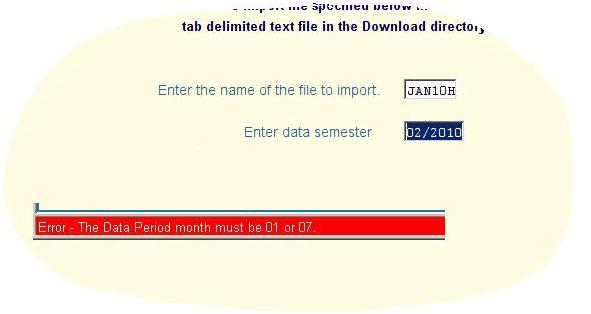 When the file is successfully imported into the Medicaid Reconciliation system, a message will confirm the import completed and report the number of records processed. The message also will remind you to set the Validate Hospital Per Diem box to Yes (checked) on the Parameter File Maintenance screen. See Activating Per Diem Editing for instructions on setting these fields on the parameter screen.
You may import the same period again if the State has sent a new or corrected file. Simply follow the same instructions except when the system detects the same period on file a warning message will be displayed, see following example. If you click the Continue button, the system will replace the existing data with the new file.
When the file is successfully imported into the Medicaid Reconciliation system, a message will confirm the import completed and report the number of records processed. The message also will remind you to set the Validate Hospital Per Diem box to Yes (checked) on the Parameter File Maintenance screen. See Activating Per Diem Editing for instructions on setting these fields on the parameter screen.
You may import the same period again if the State has sent a new or corrected file. Simply follow the same instructions except when the system detects the same period on file a warning message will be displayed, see following example. If you click the Continue button, the system will replace the existing data with the new file.
Figure: Per Diem Data Import Warning Message
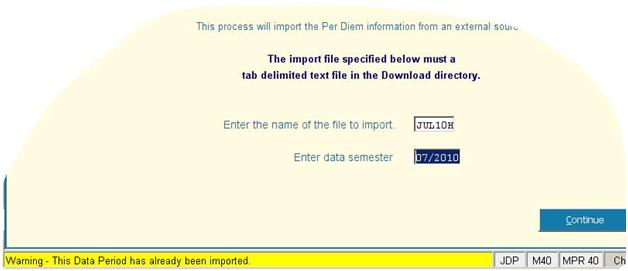 To delete a per diem semester (period) see Delete a Per Diem Data Period on the Menu-Special Functions Tab.
To delete a per diem semester (period) see Delete a Per Diem Data Period on the Menu-Special Functions Tab.
Verify Per Diem File
If Per Diem is activated, see Parameter File Maintenance, the Per Diem file must be up to date to reconcile a bill. The Verify Per Diem File routine will check for a least one record from each semester starting in 07/2001 and ending in the whatever the semester is today. If the file contains a record for each semester it is presumed up to date and the following message is displayed.Figure: Per Diem Data File Up to Date Message
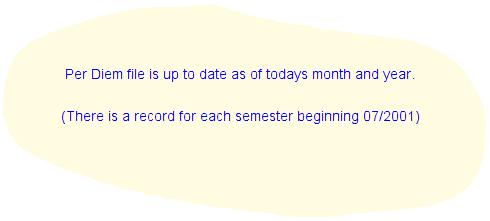 This verification is also automatically executed each time a bill is imported and will tell you if the Per Diem file is not up to date based on the current system date. If the file is up to date, the import process continues.
This verification is also automatically executed each time a bill is imported and will tell you if the Per Diem file is not up to date based on the current system date. If the file is up to date, the import process continues.
Figure: Per Diem Data File Not Up to Date Message
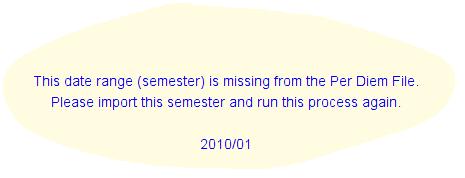
Per Diem Inquiry
This function will allow you access to specific record(s) in your Per Diem file. You may change this data by changing the mode to change(F12). The default lookup key is the provider name.Figure: Per Diem Inquiry Screen
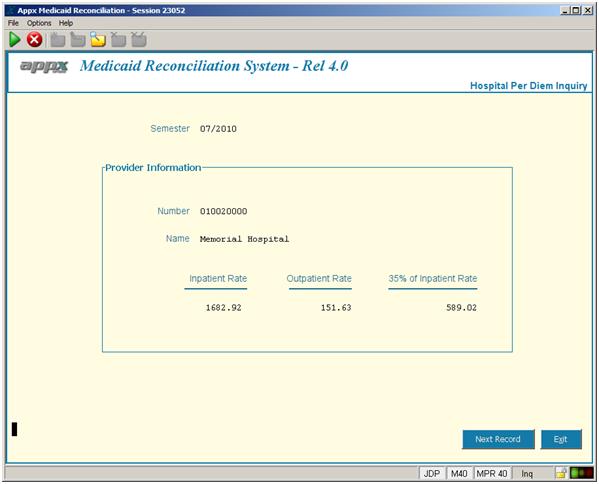
Per Diem List
This function will list the per diem data that is stored in your system. Enter the Data Period you wish to print and click Create List. Leave the Data Period blank to get a listing of the entire Per Diem file. After clicking Create List, the standard Appx Print Disposition screen will appear. Enter any specific instructions for the printed output and continue.Figure: Per Diem List Semester Screen
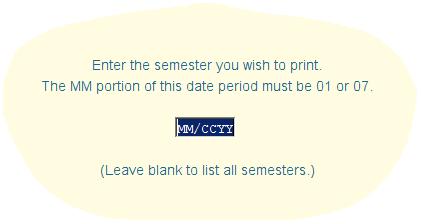 The data on the Per Diem file is a combination of the actual data from the import file (Provider Number, Inpatient Rate, and Provider Name) and a calculate amount equal to 35% of the Inpatient Rate. The 35% rate is calculated during importing and is not present in the download file from the State. The amount on the bill is compared to the 35% rate to determine if there is a billing error.
The data on the Per Diem file is a combination of the actual data from the import file (Provider Number, Inpatient Rate, and Provider Name) and a calculate amount equal to 35% of the Inpatient Rate. The 35% rate is calculated during importing and is not present in the download file from the State. The amount on the bill is compared to the 35% rate to determine if there is a billing error.
Activating Per Diem Editing
After you have completed importing the Per Diem data for the appropriate range of dates the Medicaid Reconciliation system needs to be instructed to start editing incoming hospital records while creating the exception list. This is accomplished on the Parameter File Maintenance screen. Check the box next to Validate Hosp Per Diem to activate editing. If Per Diem is activated and the calculated Per Diem on the bill is not equal to the established Per Diem value, the billing record will be listed on the exception report. You can have the system not list billing records as exceptions when the calculated Per Diem is less than the set Per Diem rate. Check Allow Amounts Less Than Per Diem to apply this edit. The following example shows the new flags on the Parameter File Maintenance screen. For illustration purposes the flags are set to Yes (checked means yes). Initially theses flags will be set to No (blank, not checked).Figure: Activation Flags on the Parameter Screen
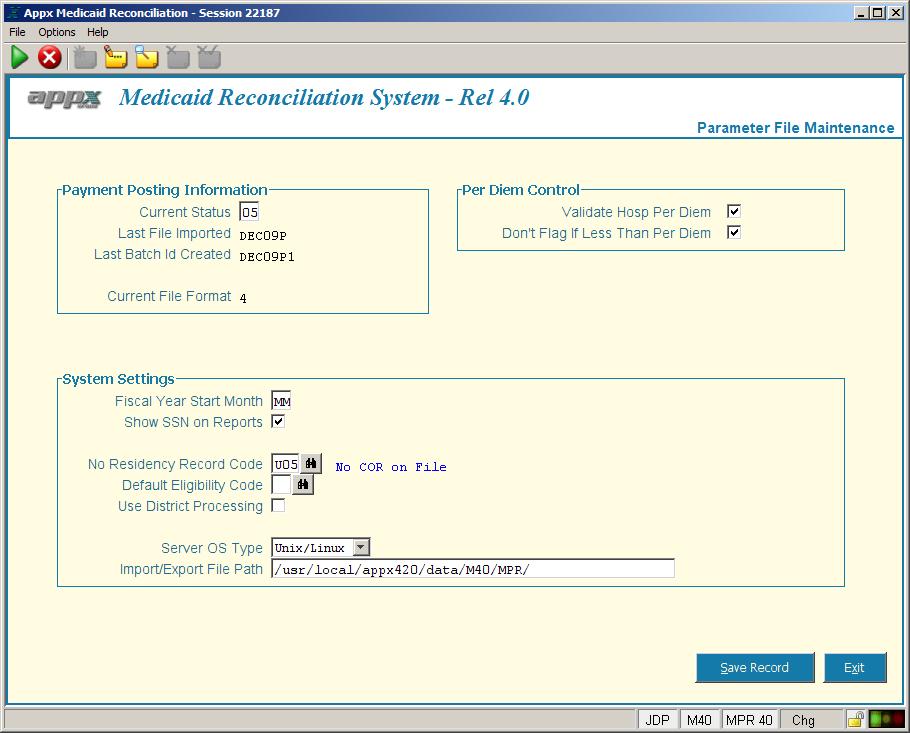
Menu-Reconciliation Tab
Figure: Reconciliation Menu Screen
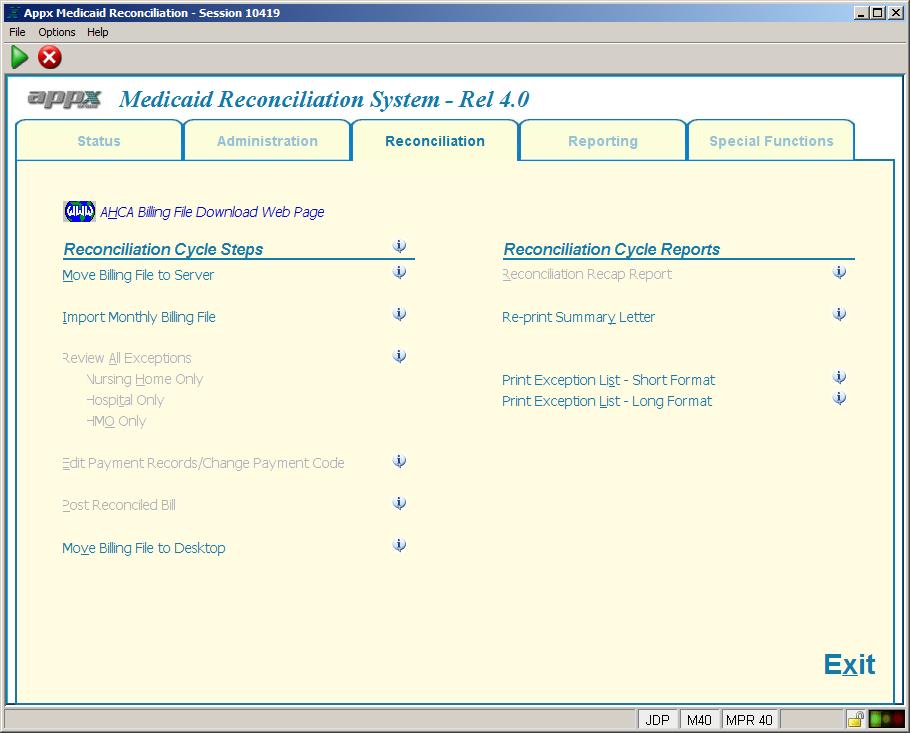 The illustration above shows the Reconciliation Menu before starting a reconciliation cycle. The functions on this menu will become active (teal) or inactive (gray) depending on the reconciliation step you are in.
The illustration above shows the Reconciliation Menu before starting a reconciliation cycle. The functions on this menu will become active (teal) or inactive (gray) depending on the reconciliation step you are in.
Reconciliation Overview
The electronic bill is available to Florida Counties each month on the AHCA web site. You download the bill from the web site, save it on your computer, and using the Appx MPR system import the bill for processing. The bill contains six categories of data (billing types); Nursing Home (NO) Nursing Home Adjustments (NZ) Hospital (HO) Hospital Adjustment (HZ) HMO (LO) HMO Adjustments (LZ) Each record in the bill contains a Payment Code. The default Payment Code of P00 indicates the county will reimburse the State for this particular client (record). All records in the monthly bill are initially coded with P00. The process of reconciling is to determine if the client is an eligible county resident. If the client is an eligible county resident nothing needs to be done to this record, however if this client is not a resident or eligibility cannot be determined then you may want to change the P00 payment code to one of the following (Denial Codes); U01 – P.O. Box or General Delivery U02 – Out of State Address (Hospital Only) U03 – Not a County Resident U04 – Recipient in State Owned Facility U05 – No Residency record on File U06 – Homeless U99 - Other The monthly bill may contain hundreds and hundreds of client records. With the Appx MPR system you can pre-approve/deny clients and save their eligibility status (and default payment code). When the next bill is imported the list of pre-approved/denied clients is checked against the incoming bill. If the client has been pre-approved the MPR system will pass this record on to the final step, you don’t have to do anything with these records. The remaining records, including pre-denied, are exceptions. These exception records are displayed on your computer during reconciliation for you to review. The more clients you have pre-approved/deny the fewer exception records you will have to review. The fewer the records, the faster you can reconcile the bill each month. This is particularly important with nursing home records since they make up the majority of the records in the bill and because they typically re-occur each month. There are two ways of pre-approving/denying a client. Both methods involve creating a Residency record in the MPR system and selecting an eligibility code. See below for details on how to create a Residency record. As you review each exception record, you determine the clients’ eligibility per your counties requirements. If the client is not eligible then you change the Payment Code accordingly, and then create a Residency record. Next month when the exception list is built this client will be automatically set to the payment code established for that eligibility code. Although the Payment Code has been changed, these records are still displayed on the exception list for your review (if that parameter is checked in the Eligibility table).Download the monthly bill
Monthly billing files must be downloaded and imported into the MPR system. Once the file is imported into the APPX system, the billing reconciliation process can begin. In order to gain access to the Florida Medicaid internet site you must have a valid Username and Password. To obtain a Username and Password please call AHCA at 1-850-298-7123. Appx Software does not provide access to this web site. When you have a username and password, Click on either the WWW icon or the words AHCA Billing File Download Web PageFigure: AHCA Login Screen
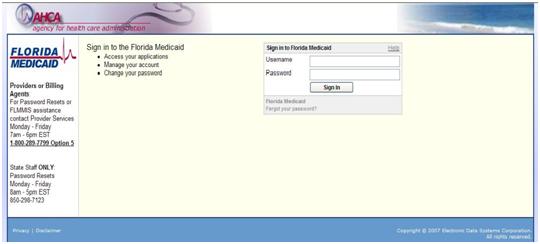 Enter your username and password and click Sign In. These fields are case sensitive.
Enter your username and password and click Sign In. These fields are case sensitive.
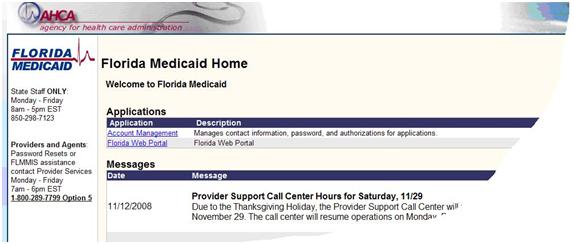 After entering your user id and password you should get a page that looks similar to the illustration above. Click on the blue words “Florida Web Portal”. The following page is displayed.
After entering your user id and password you should get a page that looks similar to the illustration above. Click on the blue words “Florida Web Portal”. The following page is displayed.
 Hover your mouse pointer over the words “Trade Files” and you will see drop down with two selections, “download” and “upload”, as shown in the following illustration.
Hover your mouse pointer over the words “Trade Files” and you will see drop down with two selections, “download” and “upload”, as shown in the following illustration.
 Click “download” and the following screen will be displayed.
Click “download” and the following screen will be displayed.
 This screen asks you to enter information to build a list of files that are available for downloading. Click on the down arrow in the field Document Type and select “COUNTY BILLING FILE”. The Date Available field has two purposes. If you enter a date (MM/DD/CCYY), the only files that will be listed are those that became available from that date forward. If the date is blank, all the files that you have not downloaded are displayed. Note that if a date is entered, you may see files that you have already downloaded. Those files will have a download date associated with them. Example:
Click on the “search” button after fields are entered.
This screen asks you to enter information to build a list of files that are available for downloading. Click on the down arrow in the field Document Type and select “COUNTY BILLING FILE”. The Date Available field has two purposes. If you enter a date (MM/DD/CCYY), the only files that will be listed are those that became available from that date forward. If the date is blank, all the files that you have not downloaded are displayed. Note that if a date is entered, you may see files that you have already downloaded. Those files will have a download date associated with them. Example:
Click on the “search” button after fields are entered.
Figure: AHCA Web Site for Selecting Monthy File (Bill)
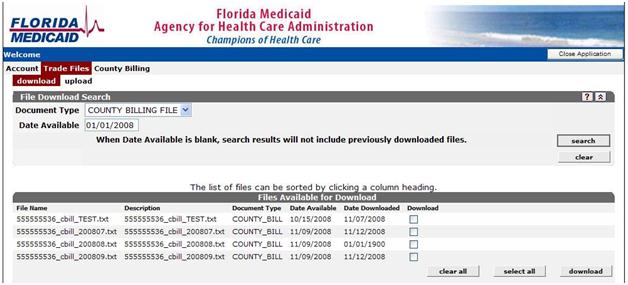 The above illustrates the results of a search for 01/01/2008 (test data). Bills that are available for download are listed. The File Name, Description, the Document Type, Actual Date Available, and the Date this file was previously Downloaded, if applicable, is shown. Use this list to select the file you wish to download and click the “download” button in the lower right corner.
The above illustrates the results of a search for 01/01/2008 (test data). Bills that are available for download are listed. The File Name, Description, the Document Type, Actual Date Available, and the Date this file was previously Downloaded, if applicable, is shown. Use this list to select the file you wish to download and click the “download” button in the lower right corner.
Do not download more than one file at a time.
Downloading creates a single file. Selecting multiple files for downloading creates a single file that will contain data from different months, not a good thing for reconciliation. You can download one file, save it locally then, while on this web page, download another and save it, presumably to another file name. Each monthly billing file represents a “batch” to the MPR system. After clicking the download button you will get a screen pop-up similar to the following;Figure: File Download Pop Up
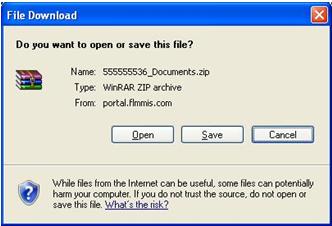 Click Save. The Save As windows is displayed. Save the file to your desktop. Depending on your computer setup the file will have to either be uncompressed or can be opened and saved using Notepad. The file eventually needs to be named and saved as a tab delimited text file on your desktop. Give is a name you’ll remember for the next step.
If you need help with this step, please call your local IT department. Appx does not include software for un-zipping a file. Un-zipping software should be installed on your computer by default. Your IT department might have disabled this software or installed a different version.
Click Save. The Save As windows is displayed. Save the file to your desktop. Depending on your computer setup the file will have to either be uncompressed or can be opened and saved using Notepad. The file eventually needs to be named and saved as a tab delimited text file on your desktop. Give is a name you’ll remember for the next step.
If you need help with this step, please call your local IT department. Appx does not include software for un-zipping a file. Un-zipping software should be installed on your computer by default. Your IT department might have disabled this software or installed a different version.
Start a Reconciliation Cycle
Before you can begin a reconciliation cycle you must have downloaded a bill and saved it as a tab delimited text file on your desktop. Start the MPR system and click on the Reconciliation tab. The Reconciliation menu is displayed.Figure :Reconciliation Tab
 At the beginning of a reconciliation cycle the menu should look as it does in the above example. The teal colored selections are active and the grayed selections are inactive. As you proceed through the various steps, these selections will become active or inactive to guide you through the entire process. Notice you can get to the AHCA web portal to download the file.
At the beginning of a reconciliation cycle the menu should look as it does in the above example. The teal colored selections are active and the grayed selections are inactive. As you proceed through the various steps, these selections will become active or inactive to guide you through the entire process. Notice you can get to the AHCA web portal to download the file.
Move Billing File to Server
This optional function will copy the file you saved in the previous step and place it in the proper directory (Download) on the application server. Click on Move Billing File To Server and the follow screen will be displayed. You can still get the billing file to the Download directory manually if you wish. In that case proceed to Import Monthly Billing File.Figure: Move File To Server
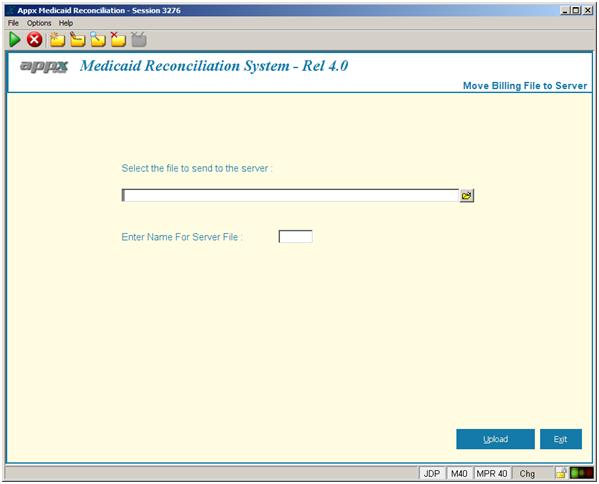 Click on the folder icon to the right of Select the file to send to the server and a windows Select File screen will pop-up.
Click on the folder icon to the right of Select the file to send to the server and a windows Select File screen will pop-up.
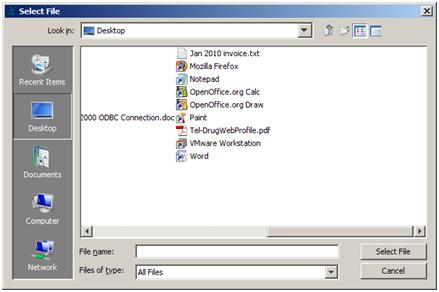 Click on your Desktop icon on the left if not already there. The “Look in” field must contain Desktop and you should be able to find the file you downloaded in the above step. In the screen shot above you can see my invoice that I named “Jan 2010 invoice.txt”. Click on your file name so that it appears in the “File name” field, example;
Click on your Desktop icon on the left if not already there. The “Look in” field must contain Desktop and you should be able to find the file you downloaded in the above step. In the screen shot above you can see my invoice that I named “Jan 2010 invoice.txt”. Click on your file name so that it appears in the “File name” field, example;
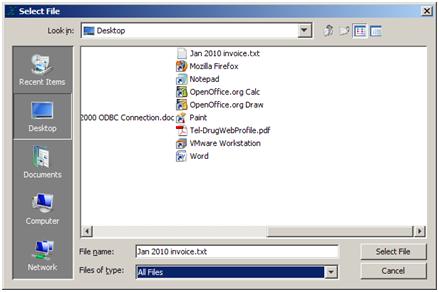 Once your file is chosen click on the Select File button. The entire path to this file is displayed on the Move Billing File to Server screen as such;
Once your file is chosen click on the Select File button. The entire path to this file is displayed on the Move Billing File to Server screen as such;
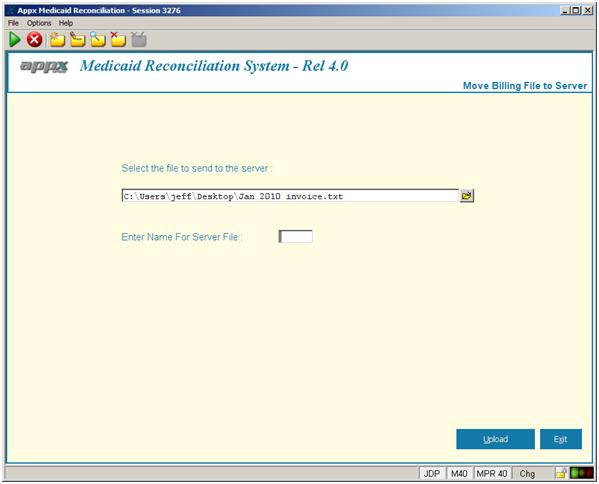 Press the tab key to move the cursor to the next field. In the field Enter Name For Server File enter the MPR billing file name. The Name For Server File must be in the format of MMMYYP where MMM is a three character upper case letter month and YY is the two digit year. The P is a designator that this is the Primary Bill for the month. You do not need to enter the .txt extension. Example;
Press the tab key to move the cursor to the next field. In the field Enter Name For Server File enter the MPR billing file name. The Name For Server File must be in the format of MMMYYP where MMM is a three character upper case letter month and YY is the two digit year. The P is a designator that this is the Primary Bill for the month. You do not need to enter the .txt extension. Example;
Figure: Identify File to Send to Server Screen Example
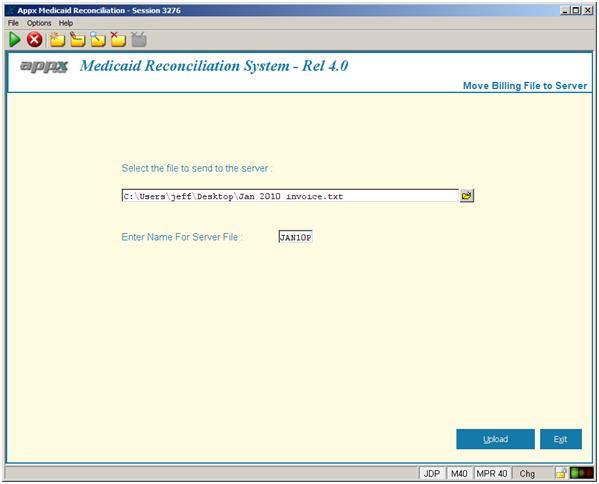 Notice that the bill was named ‘Jan 2010 invoice’ on my desktop and I am going to move it to the server (upload) as JAN10P. Click on Upload when you’ve entered the proper billing file name. The valid month abbreviations are as follows;
JAN, FEB, MAR, APR, MAY, JUN, JUL, AUG, SEP, OCT, NOV, DEC.
The file is copied to the MPR server and placed in the Download directory, where it’s suppose to be, and a message (green bar on bottom of screen) will let you know the file transfer was complete (or not). Click on Exit to return to the Reconciliation menu.
Notice that the bill was named ‘Jan 2010 invoice’ on my desktop and I am going to move it to the server (upload) as JAN10P. Click on Upload when you’ve entered the proper billing file name. The valid month abbreviations are as follows;
JAN, FEB, MAR, APR, MAY, JUN, JUL, AUG, SEP, OCT, NOV, DEC.
The file is copied to the MPR server and placed in the Download directory, where it’s suppose to be, and a message (green bar on bottom of screen) will let you know the file transfer was complete (or not). Click on Exit to return to the Reconciliation menu.
Import Monthly Billing File
Before starting this step the billing file must be on the server with a properly formatted name. If Per Diem is activated, the Per Diem file will be verified using the current date. An error message will be displayed telling you which semester is missing, if applicable. From the Reconciliation menu click on Import Monthly Billing File. The Import Monthly Bill screen is displayed. Enter the Server Billing File name and click continue;Figure: Reconciliation, Enter File Name
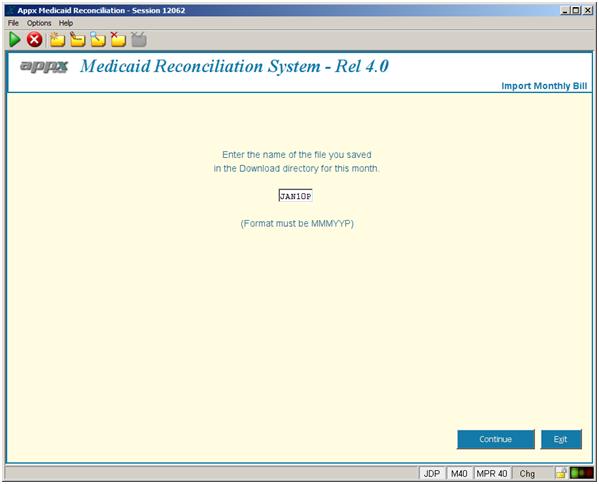 If the file is not found a message similar to the following is displayed;
If the file is not found a message similar to the following is displayed;
Figure: Reconciliation, File Name Entered is Not Found Message
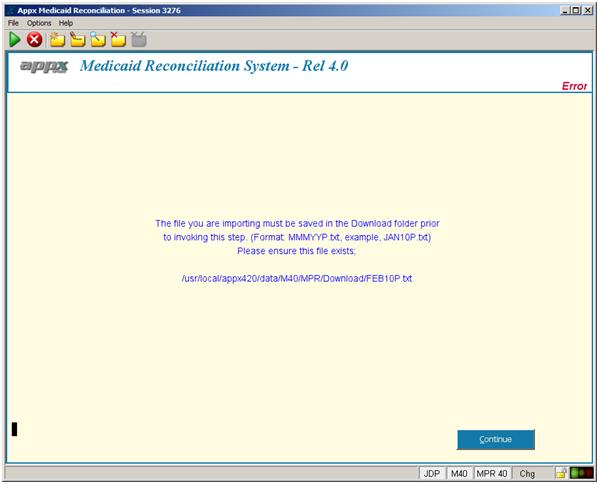 This message tells you that the file name you entered (including the .txt MPR added) cannot be found in the Download directory. The complete path for this file is displayed. Find the file and copy or move it to this directory and try again. After clicking Continue you will be taken back to the previous screen.
When the file is found, the MPR system will produce a raw list of the incoming data.
This message tells you that the file name you entered (including the .txt MPR added) cannot be found in the Download directory. The complete path for this file is displayed. Find the file and copy or move it to this directory and try again. After clicking Continue you will be taken back to the previous screen.
When the file is found, the MPR system will produce a raw list of the incoming data.
Figure: Billing File List
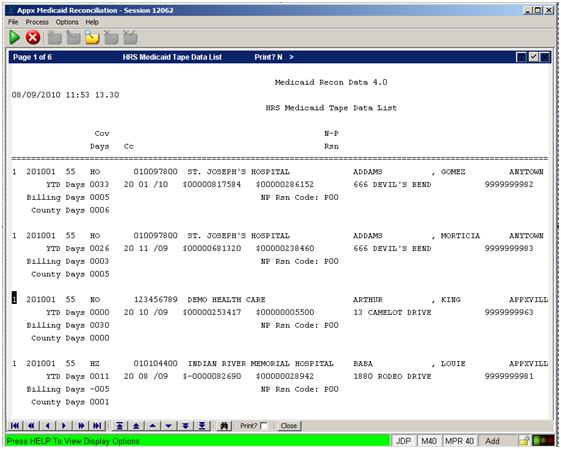 The purpose of this list is to confirm the file imported correctly. The easiest way to tell is by looking at the column for N_P Rsn, just below the report title. Everything on the incoming bill should be coded P00. You can see that on the example above. Page down a few pages to ensure the code remains P00. (Navigate the list using the blue arrows on the bottom of the screen.) Notice that Print? is unchecked. This means “No”. This report is not intended to be printed.
If you encounter a problem downloading the file or the file isn’t properly formatted the N_P Code, as well as other fields, will contain garbage. If that happens please call Appx support at 1-800-879-2779 for assistance.
After you close the on-screen list the exception list is created and the Review Exception section is activated. MPR builds a batch file name for this billing cycle. The name of the batch is displayed in the tile area of the reconciliation processes. Once a reconciliation cycle has started, then it must be processed (posted) before another bill can be imported. Although many users can access the MPR system, only one user at a time should be reconciling a batch. If you import a file and need to delete and reset the system, please call Appx support at 1-800-879-2779 for assistance.
The purpose of this list is to confirm the file imported correctly. The easiest way to tell is by looking at the column for N_P Rsn, just below the report title. Everything on the incoming bill should be coded P00. You can see that on the example above. Page down a few pages to ensure the code remains P00. (Navigate the list using the blue arrows on the bottom of the screen.) Notice that Print? is unchecked. This means “No”. This report is not intended to be printed.
If you encounter a problem downloading the file or the file isn’t properly formatted the N_P Code, as well as other fields, will contain garbage. If that happens please call Appx support at 1-800-879-2779 for assistance.
After you close the on-screen list the exception list is created and the Review Exception section is activated. MPR builds a batch file name for this billing cycle. The name of the batch is displayed in the tile area of the reconciliation processes. Once a reconciliation cycle has started, then it must be processed (posted) before another bill can be imported. Although many users can access the MPR system, only one user at a time should be reconciling a batch. If you import a file and need to delete and reset the system, please call Appx support at 1-800-879-2779 for assistance.
Reconcile Exception List
What’s happened? When the file was imported each client was cross checked with the Residency file. If a client record exists on the Residency file then the eligibility code on the Residency record is used to code this billing record. A billing record will fall into two categories, payment okay and exceptions. The Residency record is used to determine which category to put a billing file record. Payment okay records are passed through the system and you don’t necessarily have to look at them, although you can if you wish. Exceptions are the records you must reconcile. New with release 4.0 comes the ability to have the MPR system automatically mark the Payment Code on exception records based on the Residency record. See Edit Residency Verification Records. Since these records have been pre-denied sort-a-speak you have the option listing them on the exception list or not.Figure: Exception List Filter
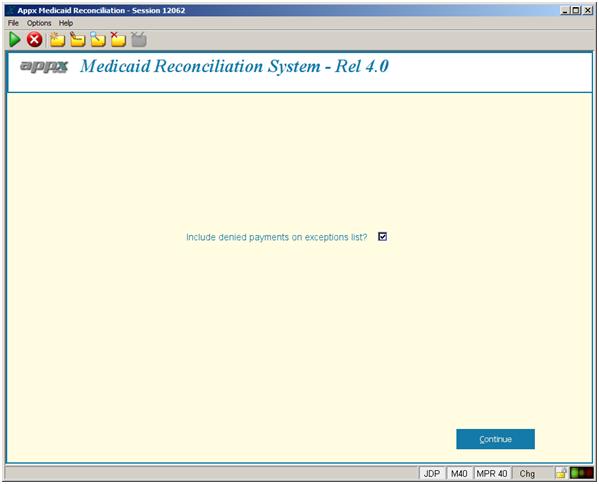 It the box on the “Include denied payments” is checked then all exceptions will be listed for you to review. If you uncheck the box, then the records already denied, either by you or the Residency record will not be listed. You have this ability to choose which way you want to see the exception list each time you view the list.
There are four functions for reconciling the exception file, Review All Exceptions, Nursing Home Only, Hospital Only, and HMO Only. Note the exception list category is displayed in the window title bar, example below. The list shows basic information for each client and the reason(s) this record is on the exception list.
It the box on the “Include denied payments” is checked then all exceptions will be listed for you to review. If you uncheck the box, then the records already denied, either by you or the Residency record will not be listed. You have this ability to choose which way you want to see the exception list each time you view the list.
There are four functions for reconciling the exception file, Review All Exceptions, Nursing Home Only, Hospital Only, and HMO Only. Note the exception list category is displayed in the window title bar, example below. The list shows basic information for each client and the reason(s) this record is on the exception list.
Figure: Exception List
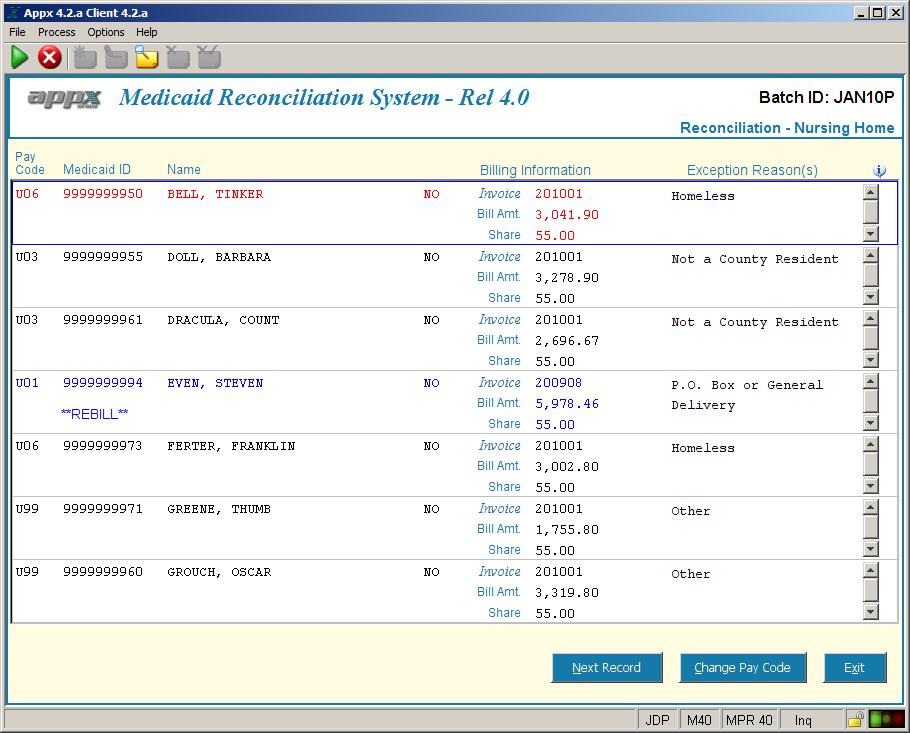 There are seven billing exception records shown on the exception list at a time, see above screen shot. The active record is outlined in blue with red text. If the record is not active the text is black. For a re-bill records, the word REBILL will be printed the Medicaid ID field and the text will be blue instead of black when inactive, and magenta instead of red when selected.
The exception list will always start on the first record for the billing type selected from the menu. Normally you want to process this list top to bottom. When you exit, MPR remembers where you are. When you return, click Go To Saved Location and the list will jump to the record you were on.
The process of reconciliation is determining if this client is a county resident. Click on Change Pay Code to see the full detail for this client record. Once you have reviewed the detail data you should be able to either accept this record or deny it. To deny a payment you need to change the payment code from P00.
There are seven billing exception records shown on the exception list at a time, see above screen shot. The active record is outlined in blue with red text. If the record is not active the text is black. For a re-bill records, the word REBILL will be printed the Medicaid ID field and the text will be blue instead of black when inactive, and magenta instead of red when selected.
The exception list will always start on the first record for the billing type selected from the menu. Normally you want to process this list top to bottom. When you exit, MPR remembers where you are. When you return, click Go To Saved Location and the list will jump to the record you were on.
The process of reconciliation is determining if this client is a county resident. Click on Change Pay Code to see the full detail for this client record. Once you have reviewed the detail data you should be able to either accept this record or deny it. To deny a payment you need to change the payment code from P00.
How to Change the Payment Code
As mentioned earlier, the default Payment Code (NR Code) is P00. P00 is the code that indicates you are going to pay the county’s share for this record. All the records in the bill you downloaded from the State are coded P00. To change a payment code and/or to see more detail for the active record, click the Change Pay Code button near the bottom of the exception list. The client detail screen shows all the information for the selected record, example;Figure: Exception List Detail Screen
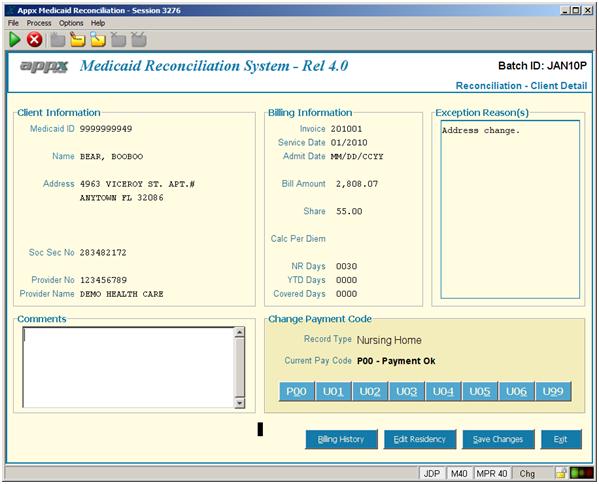 From this detail screen you can review the data on the billing record and change the Payment Code if you deem necessary. Notice that the exception reason is displayed. This is why the MPR system put this record on the exception list for you to review. There is a button to view the billing history for this client so you can see what has been done in the past.
Billing records with either have an associated Residency record or not. In the example above there is a Residency record for this client as indicated by the button Edit Residency. If there wasn’t a Residency record the button will say Add Residency. Normally you will want to always add a Residency record and set the eligibility status. Adding a Residency record for every person on the bill and setting the eligibility code will automatically set the pay code for the next bill you process. This will reduce the number of records you have to reconcile each month thus saving time. You do need to specify the pay code by clicking one of the Payment Code buttons for the current bill you are processing though.
There are only two things you can do on this screen. You can change the pay code which, will automatically save the record and return to the exception list, or you can add comments and click Save Changes (or click a Payment Code button). Comments are saved in the history file but will not appear on this record again next month. When you return to the exception list you will still be on the same record. All you need to do is click on the Next Record button on the bottom of the exception list to proceed to the next record.
Continue to review each record on the exception list. When you are finished with all the records, proceed to the next category of data or next step.
The exception list will always list records in Last Name order starting with the first client in the billing file. If you want to go to a specific record on the list press the F11 key. The list now is blank. You are in “key entry mode”. Notice that the binoculars are on the Medicaid ID field. If you know the clients Medicaid ID number you can enter it then press the Enter key. Clicking the binoculars will show you the records sorted in Medicaid ID number order. You can scroll down the list and when you find the one you want simply click on it and the exception list will start on that record. If you would rather search by Name, after pressing F11 press F3 and a Select Path screen will pop up with all the search fields listed. With your mouse, click on the words Recip Name. The black box should move to the R in the Recip Name line. Press the Enter key and you will return to key entry mode on the exception list but now the search field is set to Name. Now you can enter the clients name (last, first). If you want to start the list with the all the clients whose last name starts with the letter T, type T and press Enter.
When you exit the exception list MPR will remember where you are automatically. When you come back simply click Go To Saved Location and you jump to the last record that was active.
The buttons in this section will remain active throughout the rest of the reconciliation cycle. This allows you to start reconciling, leave Appx and return later to continue working. Once you view any exception list the Post Reconciled Bill button becomes active. Make sure you have reconciled the entire bill before posting.
From this detail screen you can review the data on the billing record and change the Payment Code if you deem necessary. Notice that the exception reason is displayed. This is why the MPR system put this record on the exception list for you to review. There is a button to view the billing history for this client so you can see what has been done in the past.
Billing records with either have an associated Residency record or not. In the example above there is a Residency record for this client as indicated by the button Edit Residency. If there wasn’t a Residency record the button will say Add Residency. Normally you will want to always add a Residency record and set the eligibility status. Adding a Residency record for every person on the bill and setting the eligibility code will automatically set the pay code for the next bill you process. This will reduce the number of records you have to reconcile each month thus saving time. You do need to specify the pay code by clicking one of the Payment Code buttons for the current bill you are processing though.
There are only two things you can do on this screen. You can change the pay code which, will automatically save the record and return to the exception list, or you can add comments and click Save Changes (or click a Payment Code button). Comments are saved in the history file but will not appear on this record again next month. When you return to the exception list you will still be on the same record. All you need to do is click on the Next Record button on the bottom of the exception list to proceed to the next record.
Continue to review each record on the exception list. When you are finished with all the records, proceed to the next category of data or next step.
The exception list will always list records in Last Name order starting with the first client in the billing file. If you want to go to a specific record on the list press the F11 key. The list now is blank. You are in “key entry mode”. Notice that the binoculars are on the Medicaid ID field. If you know the clients Medicaid ID number you can enter it then press the Enter key. Clicking the binoculars will show you the records sorted in Medicaid ID number order. You can scroll down the list and when you find the one you want simply click on it and the exception list will start on that record. If you would rather search by Name, after pressing F11 press F3 and a Select Path screen will pop up with all the search fields listed. With your mouse, click on the words Recip Name. The black box should move to the R in the Recip Name line. Press the Enter key and you will return to key entry mode on the exception list but now the search field is set to Name. Now you can enter the clients name (last, first). If you want to start the list with the all the clients whose last name starts with the letter T, type T and press Enter.
When you exit the exception list MPR will remember where you are automatically. When you come back simply click Go To Saved Location and you jump to the last record that was active.
The buttons in this section will remain active throughout the rest of the reconciliation cycle. This allows you to start reconciling, leave Appx and return later to continue working. Once you view any exception list the Post Reconciled Bill button becomes active. Make sure you have reconciled the entire bill before posting.
Edit Payment Records/Change Payment Code
This function lets you go to any record in the imported billing file, including records that were not listed on the exception list. If for any reason you need to override the P00 on a record that was pre-approved you can change it using this function.Post Reconciled Bill
The MPR system doesn’t have a way of knowing when you have looked through all the records in the exception list and weather you have completed reconciliation. So it’s up to you to determine if you have completed reconciling all the exception records in Nursing Home, Hospital, and HMO. When you have finished reconciling each record and are satisfied with the results of the trial balance, you can Post the bill. The Post option becomes available for selection as soon as you return from any of the exception list processes. Once the bill is posted you cannot return to the exception list(s) for this cycle. The following message is displayed for you to confirm invocation of the post.Figure: Post Confirmation Message
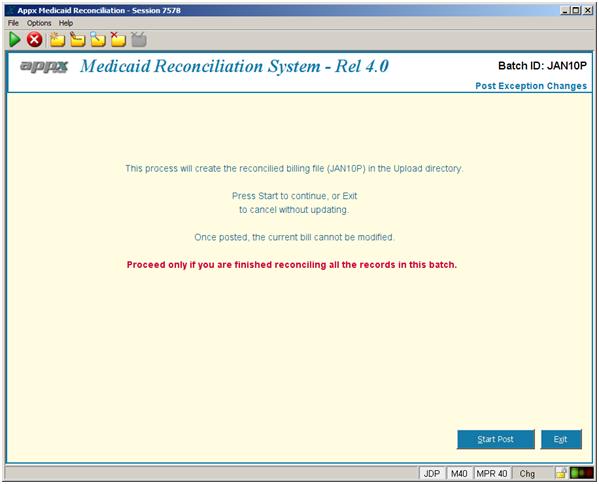 When you post the bill the MPR system merges the payments that were pre-approved with the reconciled exception list(s) and creates an updated billing file with the exact same name as the current billing file but puts it in the Upload directory on your server. The following message is displayed after the post completes.
When you post the bill the MPR system merges the payments that were pre-approved with the reconciled exception list(s) and creates an updated billing file with the exact same name as the current billing file but puts it in the Upload directory on your server. The following message is displayed after the post completes.
Figure: Post Complete Message
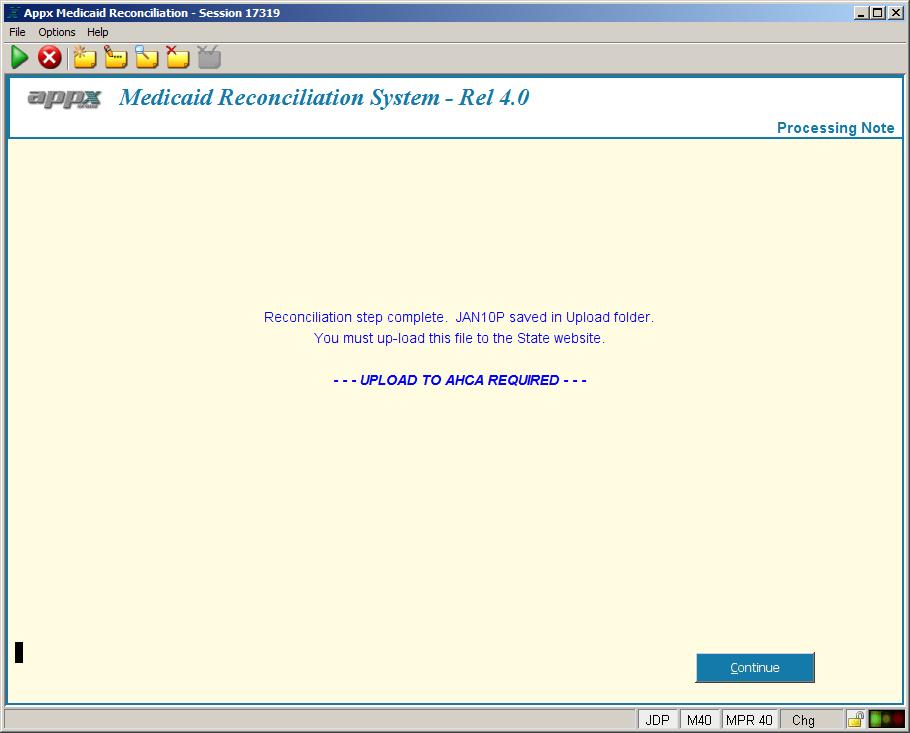 Press Continue and the MPR system will display the Summary Letter but first Appx needs a little information on the final disposition of the report. The Report Options (Disposition) screen request information anytime a report is being created. Here is an example of the Report Options screen.
Press Continue and the MPR system will display the Summary Letter but first Appx needs a little information on the final disposition of the report. The Report Options (Disposition) screen request information anytime a report is being created. Here is an example of the Report Options screen.
Figure: Report Options (Disposition) Screen
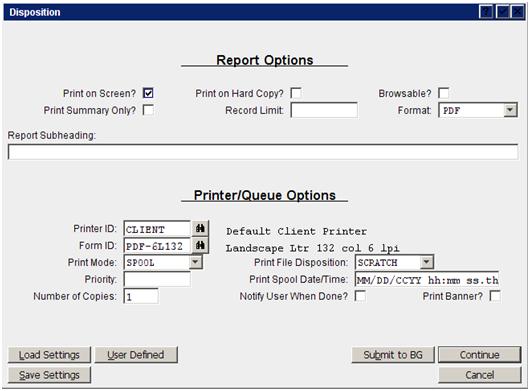 See the Appx Users Guide for details regarding the fields on this screen.
When you click on Continue from the Report Options screen, the Summary Letter will be produced and displayed on your computer screen. Example;
See the Appx Users Guide for details regarding the fields on this screen.
When you click on Continue from the Report Options screen, the Summary Letter will be produced and displayed on your computer screen. Example;
Figure: Example of Summary Letter
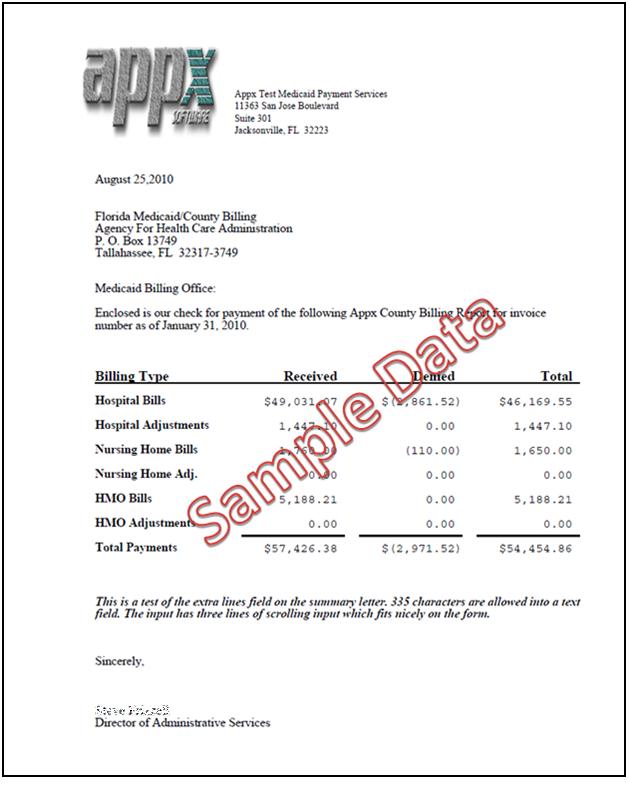 The Summary Letter is similar to the Reconciliation Recap Report but includes audit information pertaining to this reconciliation cycle.
MPR also updates the history files with the records from this cycle during the post process. The history file is actively used during reconciliation to view past payments and is also used to create reports.
The Summary Letter is similar to the Reconciliation Recap Report but includes audit information pertaining to this reconciliation cycle.
MPR also updates the history files with the records from this cycle during the post process. The history file is actively used during reconciliation to view past payments and is also used to create reports.
Move Billing File to Desktop
As mentioned above the updated billing file was created in the Upload directory on your server. This file needs to be uploaded to the State, normally after the results of the reconciliation are approved for payment. Click Move Billing File to Desktop and MPR will copy the reconciled bill from your server to your desktop. Look on your desktop for an icon with the name of the bill, JAN01P.txt for example. Now all you have to do is sent this file back to AHCA. Special note; The Move Billing File to Desktop only works for the current bill that is being reconciled. If you need to re-send a bill from another cycle you will have to get the file from the Upload directory yourself.Reconciliation Recap Report
This process will display a summary of the current cycle bill. It can be run multiple times during the cycle if you wish.Figure: Recap Report Options Screen
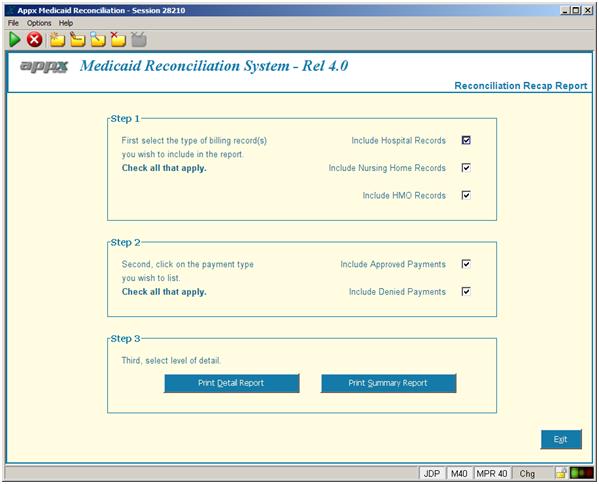 There are several options that allow you to tailor your recap report. In Step 1 you select which type of billing records to include in the report. A checkmark means that this billing type is selected. Step 2 defines which payment code types to list from the current reconciliation cycle. In Step 3 you select whether to print just totals or a report containing all the detail including totals. Warning, printing the detail report can produce a rather large listing.
There are several options that allow you to tailor your recap report. In Step 1 you select which type of billing records to include in the report. A checkmark means that this billing type is selected. Step 2 defines which payment code types to list from the current reconciliation cycle. In Step 3 you select whether to print just totals or a report containing all the detail including totals. Warning, printing the detail report can produce a rather large listing.
Figure: Recap Report Example (PDF)
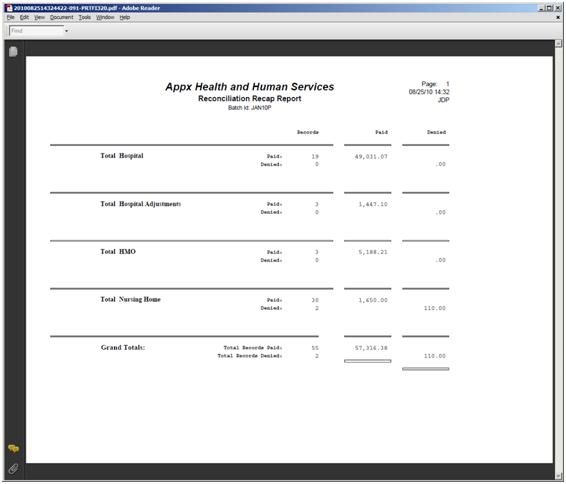 The report shows each billing category and the number and amount of approved and denied payments. Use this to evaluate the status of your current reconciliation cycle. The recap report is not intended to be printed on paper, just displayed on the screen.
The report shows each billing category and the number and amount of approved and denied payments. Use this to evaluate the status of your current reconciliation cycle. The recap report is not intended to be printed on paper, just displayed on the screen.
Re-print Summary Letter
This function simply re-prints the summary letter from the current cycle only. If you need to re-print a Summary Letter from a previous cycle go to Re-Print Summary Letter on the Reporting Tab.Print Exception List – Short Format
This report lists exception records from the current cycle. Just the basic information is shown on this report.Print Exception List – Long Format
This report lists exception records from the current cycle. The report includes most of the fields in the billing record for each client. This report emulates the printed bill that you may or may not get from the State.Print Residency Transfer Forms
This functions will print AHCA Residency Transfer Forms for each transaction in the selected Posted bill (batch) that has a denial code of U03. The default batch will be the last posted batch however prior batches can be selected. Note that the report uses transactions from Posted batches only.How to upload the reconciled bill
After the summary letter gets approved for payment the reconciled bill has to be sent (uploaded) to the State’s (AHCA) web site. As you would expect, the upload process is similar to the download process. Log into the Florida Medicaid website and select “upload” from the Web Portal > Trade files page. Click on the browse button and navigate to your desktop and select the file you just moved to the desktop. Once selected, complete any other information on the web page and click the upload button. The MPR system will automatically reset itself for the next reconciliation cycle. If you need to re-print the Summary Letter for any reason you can click on Reprint Summary Letter of Medicaid Payments on the Reconciliation menu as long as you haven’t imported another bill. If you need to re-print a Summary Report from another cycle go to the Reporting tab. Special Note: If the upload billing file size is greater than 3 megabytes it will have to be compressed before uploading it. Invoke the compression utility that is available on your computer and compress the file. Your IT folks should be able to help you with this process. As of this writing, all files have been less than 3 megabytes for all counties. The file you downloaded and moved to the server as well as the reconciled bill are still on your server in the Download and Upload directories. It is a good idea to keep these files because they can be used to recreate your history files if necessary.Menu-Reporting Tab
Figure: Reporting Tab
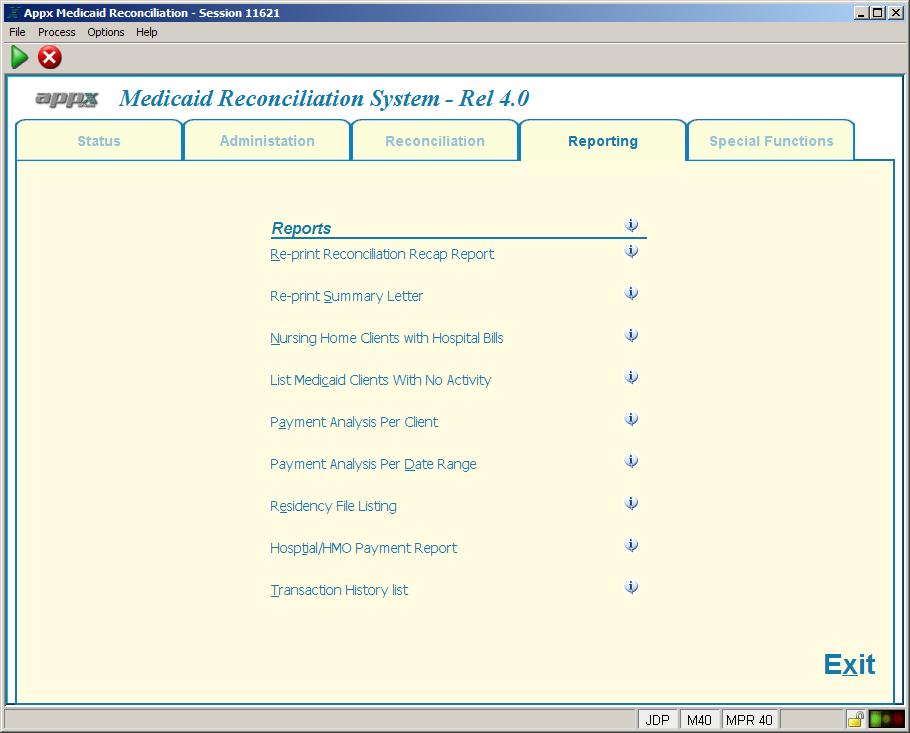 Most reports comprise a multi-process step. Depending on the design of the report some of these steps may be bypassed. The first step, if shown, is to obtain the constraints of the data. The second step, if shown, will allow you to control sort order. Step three lets you define print characteristics such as printer name, form name, etc. By default reports are displayed on your screen prior to physically printing the report on a printer.
Appx controls the disposition of your report with a screen similar to the following;
Most reports comprise a multi-process step. Depending on the design of the report some of these steps may be bypassed. The first step, if shown, is to obtain the constraints of the data. The second step, if shown, will allow you to control sort order. Step three lets you define print characteristics such as printer name, form name, etc. By default reports are displayed on your screen prior to physically printing the report on a printer.
Appx controls the disposition of your report with a screen similar to the following;
Figure: Report Options Screen
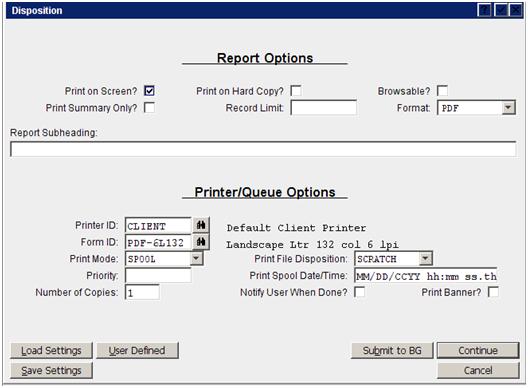 The MPR system sets the values on this screen however you can change them if you like. See the Appx User for detail information regarding the fields on this screen. Please note the Printer ID and Form ID must exist in System Administration. All reports must run using the PDF Format.
The MPR system sets the values on this screen however you can change them if you like. See the Appx User for detail information regarding the fields on this screen. Please note the Printer ID and Form ID must exist in System Administration. All reports must run using the PDF Format.
Re-Print Reconciliation Recap Report
This is a report showing the reconciliation results from a previous invoice, or batch.Reprint Summary Letter
This report allows you to print the Summary letter showing total paid and denied by billing type for any bill you have reconciled. This report also runs automatically after a batch is posted, see below.Nursing Home Clients with Hospital Bills
List nursing home clients that also have hospital billing records in history.List Medicaid Clients With No Activity
Report lists Residency records (clients) that have no billing history. Us this report to check for this condition and investigate the reason why no billing history records exist. Maybe you added a Residency record and the Medicaid ID is keyed incorrectly. You should have a least one history record for any given client.Payment Analysis Per Client
This report will combines batches from history and provides a paid/denied dollar total as well as the number of Medicaid clients assisted during the selected period. History records can be filtered by billing type. The total client’s assisted is a total of how many individuals were assisted for the range of batches selected. If the range is for one month or a year, any given client will be counted once. The paid/denied totals are a sum of all payments made for the billing type(s) selected. Adjustment records are not included in this report. When the report runs you will select the starting and ending batches. The report is inclusive of the ending batch. You will also select the type of billing record you wish to report on. You have the option to print a detailed report or a summary only. The detailed report will list all client records and can be a rather long listing. The summary sub-totals each billing type and provides an overall grand total for the entire period.Payment Analysis Per Date Range
This report will combines batches from history and provides a paid/denied dollar total as well as the total number of Medicaid clients within selected period. History records can be filtered by billing type. This report is similar to Payment Analysis Per Client however this report sums multiple occurrances of the same client(s) within the date range (batches) selected. Also, the total payments include any adjustments. When the report runs you will select the starting and ending batches. The report is inclusive of the ending batch. You will also select the type of billing record you wish to report on. You have the option to print a detailed report or a summary only. The detailed report will list all client records and can be a rather long listing. The summary sub-totals each billing type and provides an overall grand total for the entire period.Hospital/HMO Payment Report
This report will list and total the amount billed and the county share for each hospital or HMO record within a specifed range of dates (invoice dates). You are prompted for the beginning month/year and the ending month/year before the report runs. This report runs from data in the history file, therefore any batches that have not been posted will not appear on this report.Residency File Listing
List the Residency record file.Transaction History List
This function lists a specified client’s payment history.Batch Payment History Of All Clients
This reports is in a newer version of the application (4.2). This report reads your entire history file and lists each client in alphabetical order with all their payments within each batch. The report shows the billing type, batch id, service date, total amount, county share, and payment code. In addition, any comments coded in the residency file will be printed as well as each comment found from the individual bills that were entered during reconciliation.List Unpaid Transactions By Client
This reports is in a newer version of the application (4.2). This report reads your entire history file and lists clients in alphabetical order that has never been paid (P00). The report shows the billing type, service date, total amount, county share, and payment denial code. In addition, any comments coded in the residency file will be printed as well as each comment found from the individual bills that were entered during reconciliation.History Audit/Payments By Batch
This reports is in a newer version of the application (4.2). This report reads your entire history file searching for records that do not have a posting record. When you post a batch the Postings file and Payment History file is updated with the reconciled information. For each Postings record there should be history and for each history record there should be a Postings record. If not, you may be getting false results reported when reviewing data created from the history file. Also listed on this report is the number of records per batch, the payment codes broken down to show number of records, and the payment totals and adjustments.Export Residency File
This function will create a comma delimited text file of your current Residency file. The text file will be named APPX Residency File and stored on your desktop. You can import this file into a spreadsheet for analysis, however there is no way of importing this file back into the system. Any change you make to the text file will not effect the Residency file in the MPR system.Figure: Appx Residency File Desktop Icon
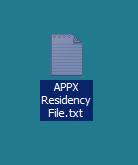
Export Payment History File
This function will create a comma delimited text file of your current Payment History file. The text file will be named APPX Payment History File and stored on your desktop. You can import this file into a spreadsheet for analysis, however there is no way of importing this file back into the MPR system. Any change you make to the text file will not effect the Payment History file in the MPR system.Export Selected Batches
This function will create a comma delimited text file for the chosen batch limited to the denial code selected. Similar to the Export Payment History File process mentioned above, however, this function allows you to define your export by batch and denial code.Menu-Special Functions Tab
Figure: Special Functions Tab
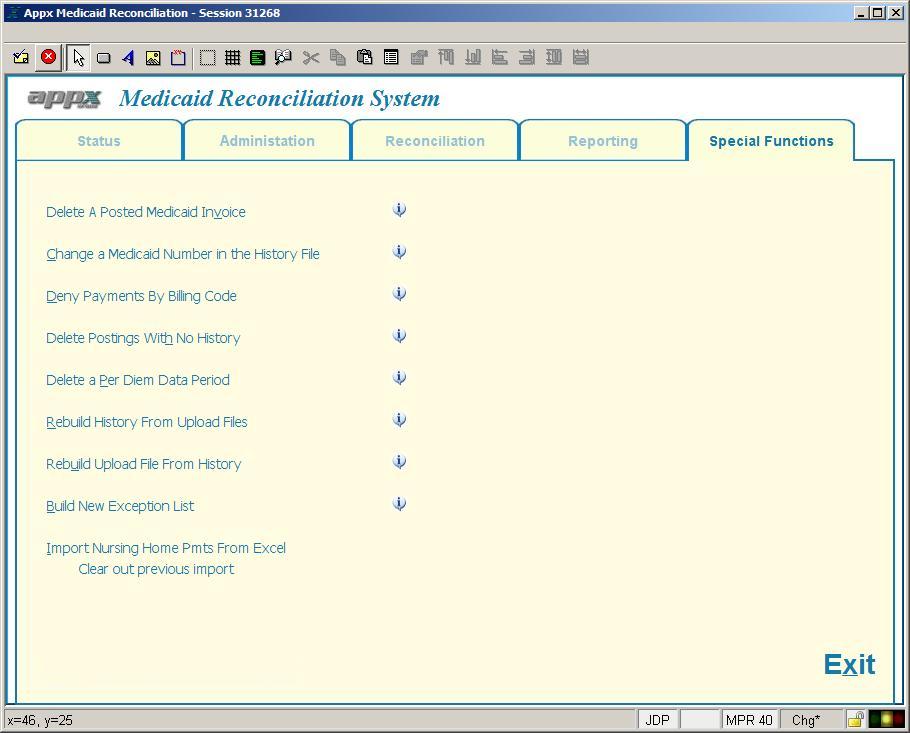 The Special Functions menu contains processes to assist you in maintaining your system or to perform batch data processing.
The Special Functions menu contains processes to assist you in maintaining your system or to perform batch data processing.
Delete A Posted Medicaid Invoice
If you imported the wrong billing file (invoice) by mistake, you can delete the batch with this function and start over.Change A Medicaid Number In The History File
If a client has their Medicaid ID number changed, this process will update the history file with the new ID number. Normally the history file is not modifiable.Deny Payments By Billing Code
This is a handy tool that will let you deny an entire group of billing records. For example, if you wish to deny all HMO records in the current cycle, you can use this function to select HMO records and then identify the denial code you wish to put on these records. This only affects the currently imported batch.Delete Posting With No History
Use this to remove batches that were started and never posted.Delete a Per Diem Data Period
Use this function to delete a per diem semester. From the Special Functions menu, click on Delete a Per Diem Data Period. The following screen will be displayed.Figure: Delete Per Diem Screen
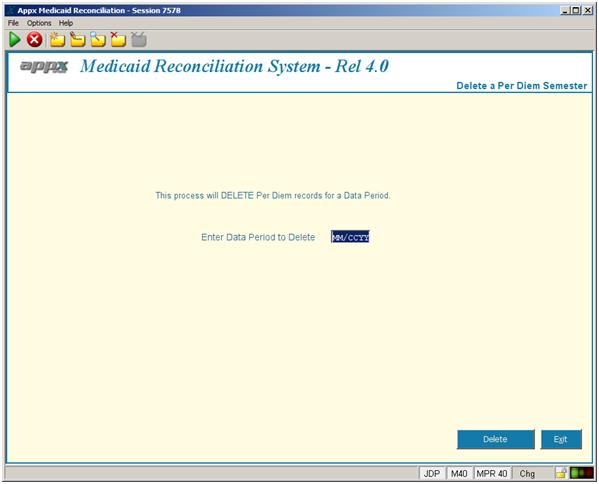 Enter the two digit month (MM) and the four digits century and year (CCYY) and click the Delete button. The month entered must be 01 or 07. If you enter a data period that does not exist on the Per Diem file an error message will be displayed. You must click the Delete button to execute this function. Pressing the ENTER key or clicking the Exit button will not delete the records. If the delete is successful you will see a message indicating how many records were deleted, see example. You can only delete one period at a time.
Enter the two digit month (MM) and the four digits century and year (CCYY) and click the Delete button. The month entered must be 01 or 07. If you enter a data period that does not exist on the Per Diem file an error message will be displayed. You must click the Delete button to execute this function. Pressing the ENTER key or clicking the Exit button will not delete the records. If the delete is successful you will see a message indicating how many records were deleted, see example. You can only delete one period at a time.
Figure: Delete Per Diem Confirmation Screen
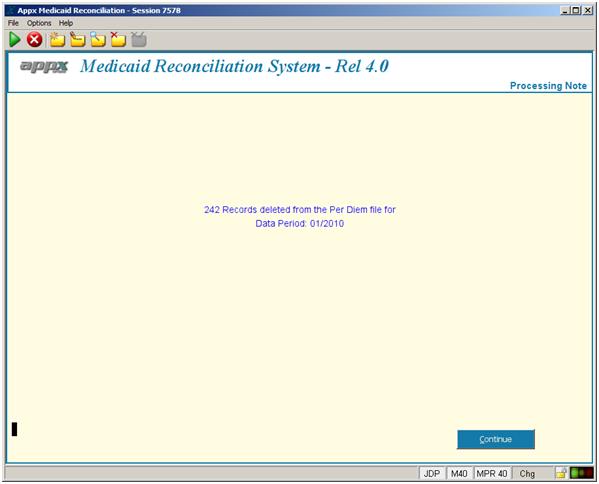 If no records were deleted, the following message will be displayed. You will see this message if you click the Exit button or pressed the ENTER key on the application screen.
If no records were deleted, the following message will be displayed. You will see this message if you click the Exit button or pressed the ENTER key on the application screen.
Figure: Delete Per Diem No Records Deleted
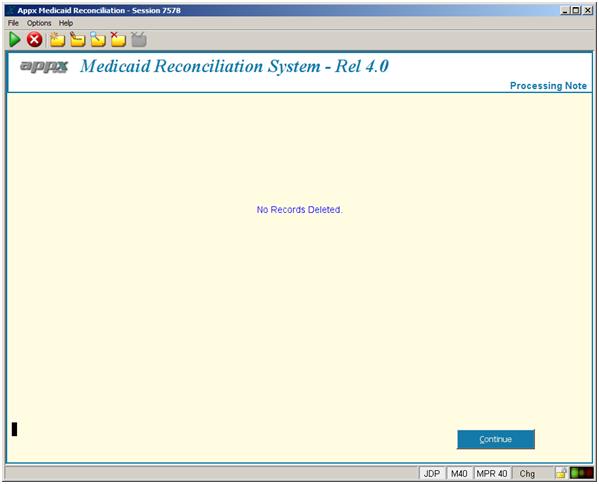
Rebuild History From Uploaded File
The reconciled files stored in the Upload directory can be used to recreate your history file in the MPR system. This function will process one upload file at a time giving you control over how much history is recovered. You will be asked to enter the upload file and the format or version of the file. If you do not know the version of the file you are selecting please call Appx. Running this process with the wrong format will result in unpredictable results and could damage your history file.Rebuild Upload From History
Using the history file in the MPR system this process can rebuild the file(s) in the Upload directory. The file created in the Upload directory will be the most current version.Build New Exception List
If you import a bill and then realize that the Residency file needs to be updated to reduce the number of exceptions, you can invoke this special process. Please note that any changes to this batch will be lost if you invoke this process. One handy way of using this function is to import a bill, go thru it and create Residency record’s for all the relevant records. Then invoke this process and the system will use the new records in the Residency file to reduce the number exceptions.Terminology
Non-payment code
The non-payment code, also referred to as NP Code or denial code, is a three character code that specifies the reason the client record is being denied. When the county bill is downloaded from the State web site all records are coded with a non-payment code of P00. P00 indicates that the county will reimburse the State for this client record. The process of reconciliation is to look at billing records and make a determination based on the data presented whether or not this client is eligible in your county. If this client is ineligible then the P00 code needs to be changed to one of the following codes; U01 = P.O. Box or General Delivery U02 = Out of State Address (Hospital Only) U03 = Not a County Resident U04 = Recipient in State Owned Facility U05 = No Residency record on File U06 = Homeless U99 = Other AHCA no longer distributes Certificate of Residency’s (COR's) for Medicaid Clients. As such, the U05 should not normally be used. Instead, you should create a Residency record, determine residency status, and code the client's eligibility in a Residency record.Exception list
The exception list is an on-line display of monthly billing records that failed the exception processing logic. The goal of the Medicaid Reconciliation system is to automatically accept pre-verified Medicaid clients and to list only those records that need manual verification. The key to the pre-verification process is having a Residency recordor Residency record on file.Exception reason
The APPX Medicaid reconciliation system will read each record from the imported monthly billing file and check the record for several criteria. If the record fails verification it will be listed on the exception report along with the reason.
Residency record
Residency records store the clients last know address, nursing home information, contact information and most importantly, the eligibility code that you establish after researching the given address. Normally you will create a Residency record while you are reconciling the monthly bill. There is an automated process that transfers the information from the bill into the new Residency record thus saving you time and eliminating any key stroke errors. Having a robust, up to date Residency File is the single most import factor in quickly reconciling bills each month.
Reconciliation Cycle
A Reconciliation Cycle begins when a file that you have downloaded is imported into the MPR system for processing. Each bill will be assigned a unique batch id. Reconciliation is a series of processing steps. Only one Reconciliation Cycle can be active at a time and must be completed (Posted) to begin a new cycle.Posting
When a bill has been completely reconciled the bill must be posted. Posting will create the billing file that you will upload to the State. Posting also updates the Payment History file in the system with the current records that have been processed. After posting a new reconciliation cycle can begin.Re-bill
For the purposes of the MPR system, re-bill means the invoice date on the record does not equal the date indicated by the batch name.AHCA
Florida Agency for Health Care Administration.Exception Reasons
These messages are printed on the exception report and indicate why that client is listed.Not this county
The county code in the Download data file for this record does not match the county code in your Agency Options parameters.No residency record
There is no Residency record on file for this nursing home client.Resident record not set for NH
A Residency record exists for this nursing home client but the “Nursing Home Verification?” field is not checked. When this field is not checked the Residency recordexists but is inactive.Address change
There is a difference in the address on the Residency record and the billing record. While viewing the Residency record you can quickly see the difference by clicking on the Show Address On Bill button.Missing required value(s)
For this Hospital or HMO client either the Covered Days or County Share is missing (zero). These two items are required to calculate Per Diem. This error will only occur if “Validate Hosp Per Diem” and/or Validate HMO Per Diem” is checked on the Parameter File Maintence screen.Per Diem values not found
For this Hospital or HMO client the system could not find a Per Diem record for the given provider and/or for the specified service period. This error will only occur if “Validate Hosp Per Diem” and/or Validate HMO Per Diem” is checked on the Parameter File Maintence screen.Per Diem mismatch
The calculated Per Diem rate for this Hospital or HMO client during the given service period does not equal the value specified in the Per Diem file for this provider. This error will only occur if “Validate Hosp Per Diem” and/or Validate HMO Per Diem” is checked on the Parameter File Maintence screen. There is a button on the exception list screen that will display the valid per deim values for this provider.Resident hospital flag not set
For this Hospital or HMO client there is a Resident record on file but the “Hospital Verification” field is not checked. When this field is not checked the Resident record exists but is inactive.County share is more than the bill amount
The specified County share for this record is greater than the specified bill amount. This exception can occur on all record types.Unpaid record for client
For adjustment transactions (NZ,HZ,LZ), the system looks in the history file for a matching payment amount for this client. If one is found and it was paid, then the adjustment is okay. If the offset history record for this adjustment was denied this error will be listed.No record in history for credit offset
A matching history could not be found for this adjustment. This means that you have never received the payment transaction the current transaction is attempting to adjust.Adj, check for matching credit/debit bills
All adjustment records are listed as exceptions. This message is printed as a reminder to check for a matching credit/debit transaction.Rebill payment previously approved
This rebill record has already been paid. There is a matching payment, P00, in the history file.Duplicate service date record in history
This non-rebill payment has already been paid for this service period.Current bill contains duplicates for this service period
There is a record in this bill for this client for this service period.Service date is prior to medicaid admit date
The service date specified is before the “Admit Date” on the Residency recordfor this client.Service date is later than date of death
The service date specified is after the “Date of Death” on the Residency recordfor this client.Service date is later than date moved out
The service date specified is after the “Moved Out” date on the Residency recordfor this client.Tips and Techniques
Known Bugs
Feature Request
Do you have an idea that would help you reconcile your bill each month? Let us know and we'll look at adding your suggestion in a future release. If you can’t wait, we can customize your version and get it to you much faster. Just give us a call and we’ll send you a quote. </form> -- GaryRogers - 2011-03-01Topic revision: r5 - 2012-05-07 - JeffPrentice
Ideas, requests, problems regarding TWiki? Send feedback

